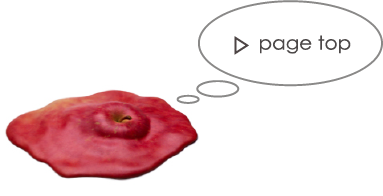
for the group show AOMORI EARTH2019, AGROTOPIA –WHEN LIFE BECOMES ART THROUGH LOCAL AGRICULTURE
2019. 展覧会、青森EARTH2019:いのち耕す場所 -農業がひらくアートの未来、のための(長い)アーティストステイトメント。
元々は展覧会のプロポーザルのために書いた文章で、それに手を加えたものです。
>>PDF English
>>PDF 日本語
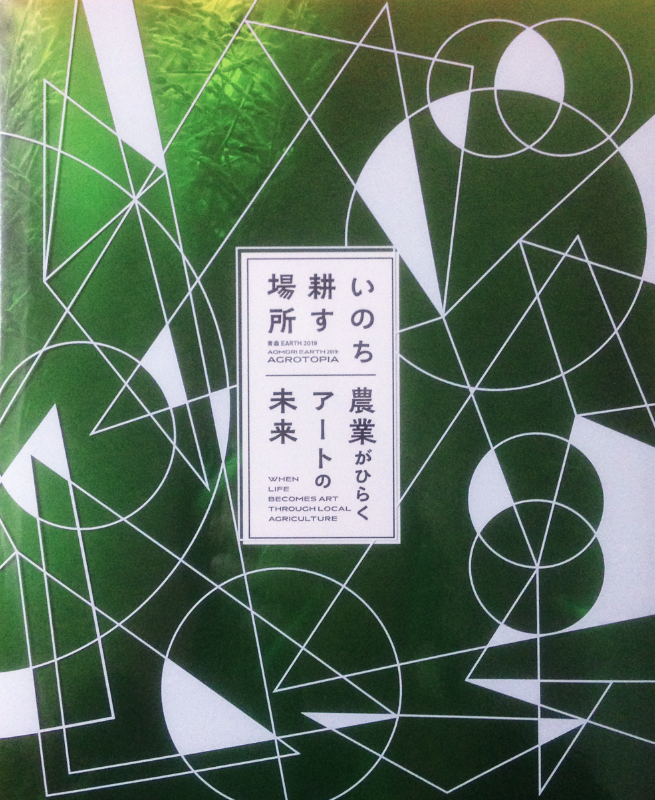
AOMORI EARTH2019, AGROTOPIA –WHEN LIFE BECOMES ART THROUGH LOCAL AGRICULTURE 2019.
執筆者:奥脇崇大(本展覧会キュレーター)、雨宮庸介、江渡狄嶺、ジョン・ラスキン、ジャン=フランソワ・ミレー、常田健、ザ・ユージーン・スタジオ、岩名泰岳、青森の農具、リ・ビンユアン、丹羽良徳、青森の教育版画 田中功起、安藤昌益、オル太、久保寛子、塚本悦雄、浅野友理子、大小島真木+アグロス・アートプロジェクト、三原聡一郎、森元斎、フー・ファン、山内朋美、片岡龍、白鳥克之、東千茅、椹木野衣、(ボーナストラック:遠藤水城)
Shops: AOMORI MUSEUM OF ART

Web Magazine(JP/machine translation EN/CN) 美術手帖 30 November 2019
農業から見えるこの国の課題。保坂健二朗評「青森EARTH2019:いのち耕す場所 −農業がひらくアートの未来」
https://bijutsutecho.com/magazine/review/20990
農業から見えるこの国の課題。保坂健二朗評「青森EARTH2019:いのち耕す場所 −農業がひらくアートの未来」
https://bijutsutecho.com/magazine/review/20990

弘前経済新聞 2019.11.27 特集「青森EARTH2019:いのち耕す場所」企画展 アートとしての農業を楽しむ
https://hirosaki.keizai.biz/column/22/
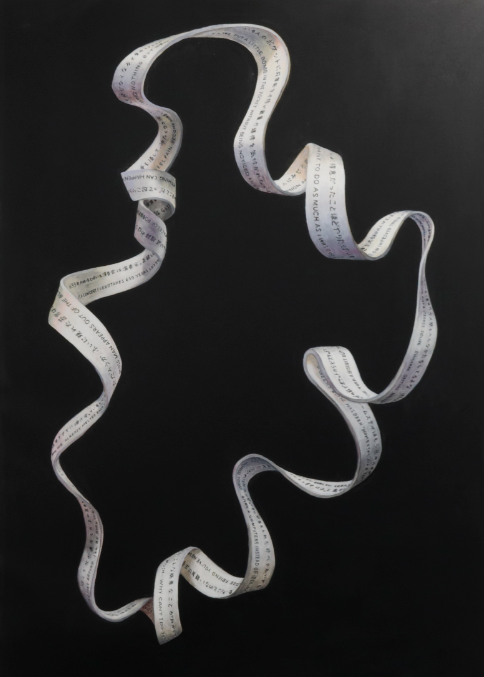
Yosuke Amemiya | ”Phantom Manuscript”
In response to the question “how should we build a relation with the world in this era, where we are given computers instead of ideology?,” the community of a family has the “force beyond reasonable judgement” which nations and class systems have lost. Thus, “in other words, one could say a family may become a political identity because it has this force.” (Hiroki Azuma, Genron 0: Kanko-kyaku no tetsugaku (The Philosophy of a Tourist), Chapter 5: Family, 2017)
While I was preparing for my exhibition and was thinking of creating new drawings that would become manuscripts of my performances, two of my family members came into the danger of death by different diseases last month, which gave me a huge shock. (The situation has settled down while I am writing this now.)
Although I thought of intaking this occurrence into my work, it was too personal to do so, and was also an incident that was mentally and physically too heavy for me. However, when looked from a more distanced point of view, I also noticed that similar occasions would be happening to people in turn, and that after all was not a rare event for humanity at all. It was quite a complex situation that I was put in.
Eventually, it occurred to me that examining a “family” might have a close relationship with elements I had been practicing in my works, including “going back and forth boundaries” or “giving mass to matters in which do not have.” Cautiously, I started to handle these incidents in parallel to my work.
A unit of a family in the contemporary era in which the internet had spread everywhere is certainly a strange place where the living body and its mind intertwine with each other. Furthermore, people perform “themselves” to complete their everyday duty in the name of life. When thinking this way, I felt the “manuscripts” I had been drawing for my performances and projects towards the society seemed to occasionally have similarity with the practice of telling stories of my family.
I sensed that not only “manuscripts of my performances and projects” but also the “manuscripts of my family” would lead to the query of “where ‘I’ end; where ‘we’ begins and ends,” which I had always been questioning.
“Art” and the “family” may appear as incompatible existences, however, I felt that perhaps they both are both covered with a “translucent obscure film.” I thought this film may radiate philosophy, sociology, biology, and even quantum physics, just as seven-colored rays of light made visible by prism when I looked through it.
Late July, 2019
Yosuke Amemiya
個展のためのステイトメント
ー幽霊の原稿ー
「イデオロギーのかわりにコンピューターが与えられた時代において、僕たちはどう世界と関係をもつべきか。」という問いに対して、家族というコミュニティには国家や階級が失った「合理的な判断を超えた強制力」があり、それゆえに「裏返せば、むしろそれがあるからこそ家族は政治的アイデンティティの候補になりえるのだとも言える。」
(「」内はすべて 東浩紀 (2017)『ゲンロン0 :観光客の哲学』 第5章 家族 より )
パフォーマンスの原稿にあたるようなドローイングで展覧会をつくってみようと進めるなか、つい先月、家族のうちの2人が別々の病気で命の危険にさらされる事になり、 大きなショックを受けました。(これを書いている現在、事態はずいぶん落ち着いている)
何か作品で触れてみようかとも考えたのですが、作品に持ち込むには個人的すぎるし、心情的にも物理的にもあまりに大きな出来事である一方、俯瞰してみれば、多くの人に順々に起こるであろう、人類においてはとりたてて珍しくない事態でもあるという、なんとも扱いにくい状況に身を置くことになったのです。
しかし、しばらくして、ふと、「家族」を考える事は、いつも自分が作品でしている実践「境界を行き来すること」 や「ないはずのことに質量を与えてしまう」などの試みに密接な関係があるのではないかと感じ、まずはおそるおそる並列に扱ってみる事にしました。
たしかに家族という単位は、インターネットが隅々まで普及した現代において、生身の身体という物質と思考が交錯する奇妙な舞台です。そして、そもそも人は「自分」という役まわりをまっとうするために日々を人生と銘打って演じているわけです。そう考えると、社会に向けたパフォーマンスやプロジェクトのために描いていた「原稿」たちもまた、時として家族を物語ることと相似形をとるように思えたのです。
「パフォーマンスやプロジェクトについての原稿」はもちろん「家族の原稿」もまた、「どこで“わたし”がおわり、“わたしたち”がどこではじまり、どこで終わるのか」という僕が常々取り組んできた問いに繋がるのだと予感しました。
「美術」またはそれとはおおよそ相容れにくい「家族」という存在も、実はどちらも表面は「半透明の見えにくい皮膜」で覆われており、その皮膜を透かしてみると、プリズムによって可視化された七色の光線のごとく、放射状に哲学や社会学、生物学や量子物理学さえも放出されるのではないかと思えたのです。
2019年7月末
雨宮庸介

Production in public/Auction (charity) at Arts Chiyoda 3331
by ONE PIECE CLUB, September 16, 2019
※リクエストされていたあいちトリエンナーレへのメッセージをその場で作り、読み上げからはじめるパフォーマンスをし、その場でその紙をオークションしにかけて寄付としました。
※読みにくさや時間の足りなさも含めて手書きとしました。
>>手書き原稿

“A Hole, and You” 「あ、あな、あなた」 by Yosuke Amemiya
Author/Editor:Yosuke Amemiya
Interview/Translation:Asuka Kiriyama
Photo (color):Kenji Otani
Art direction/Design:Shunsuke Onaka (Calamari Inc.)
Printed by Omura Printing Co., Ltd.
Published by ARTS ISOZAKI Email: hiroya_isozaki@icloud.com
B5 判(H 257× W 182mm) 中綴じ 40頁
定価 ¥1,000(税別)
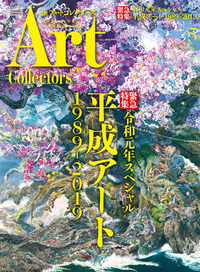
Art Collectors アートコレクターズ No.122 2019年5月号
緊急特集 令和元年スペシャル 平成アート1989-2019
◆私が選ぶ平成のこの1点 土屋誠一─雨宮庸介「THE WORLD」
選者:秋元雄史、岡部あおみ、草薙奈津子、小勝禮子、島敦彦、高階秀爾、建畠哲、成相肇、土方朋司、本江邦夫、飯沢耕太郎、金子堅治、黒瀬陽平、篠原資明、武田厚、立島惠、土屋誠一、長谷川裕子、水沢勉、鷲田めるろ

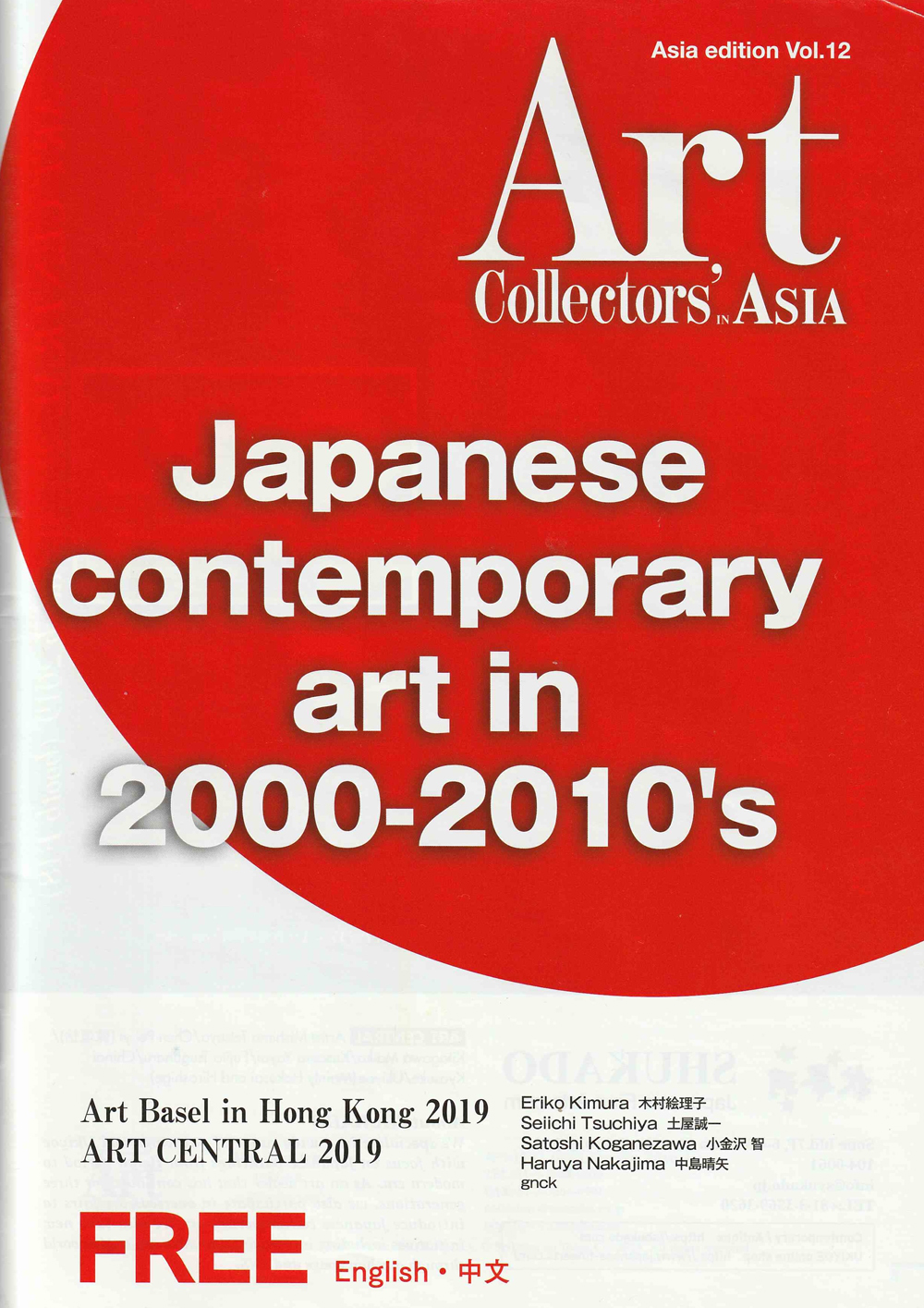
Art Collestor's in ASIA
"Japanese contemporary art in 2000-2010's"
Art Basel in Hong Kong 2019, ART CENTRAL 2019
Eriko Kimura, Seiich Tsuchiya, Satoshi Koganezawa, Haruya Nakajima,gnck
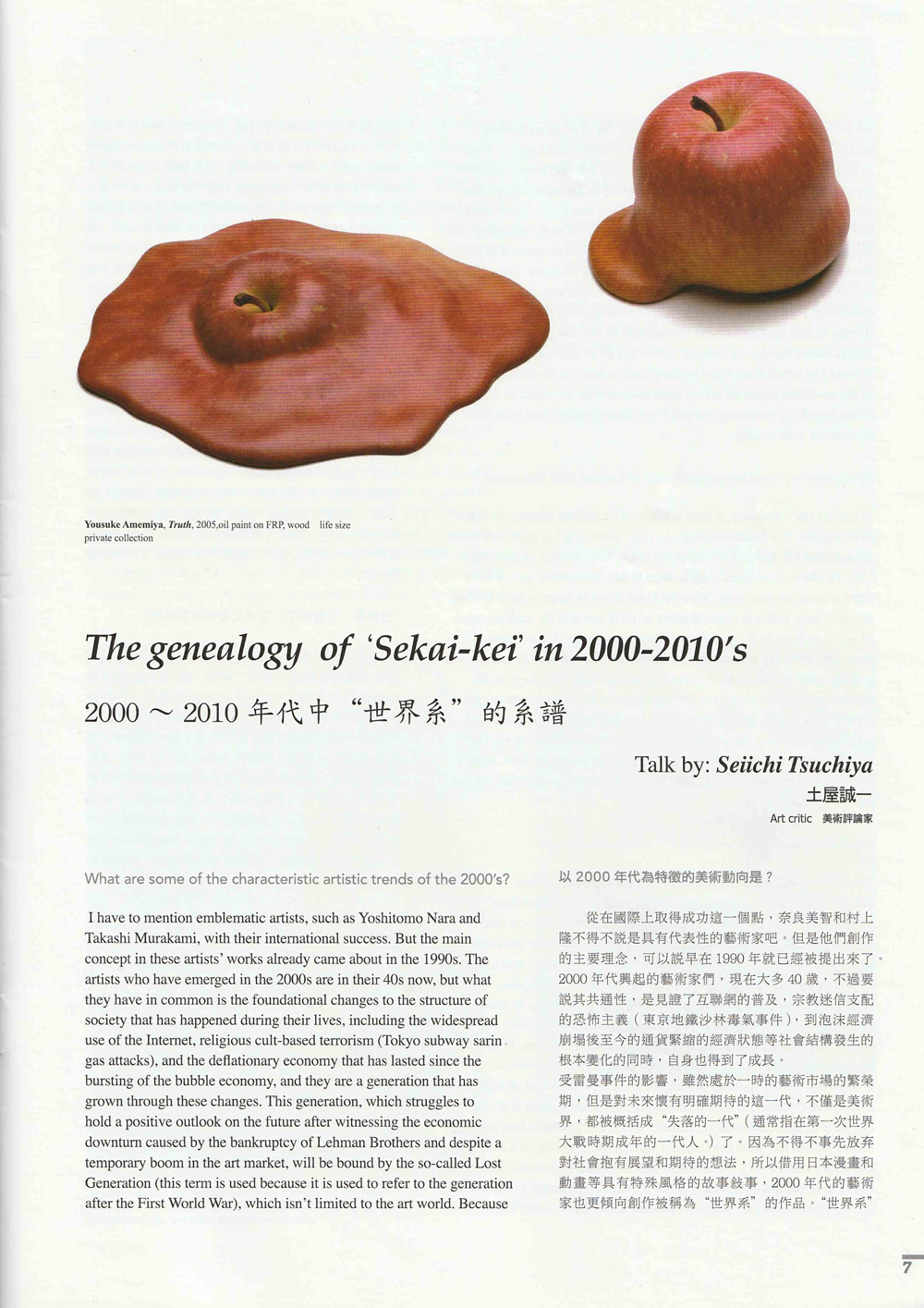
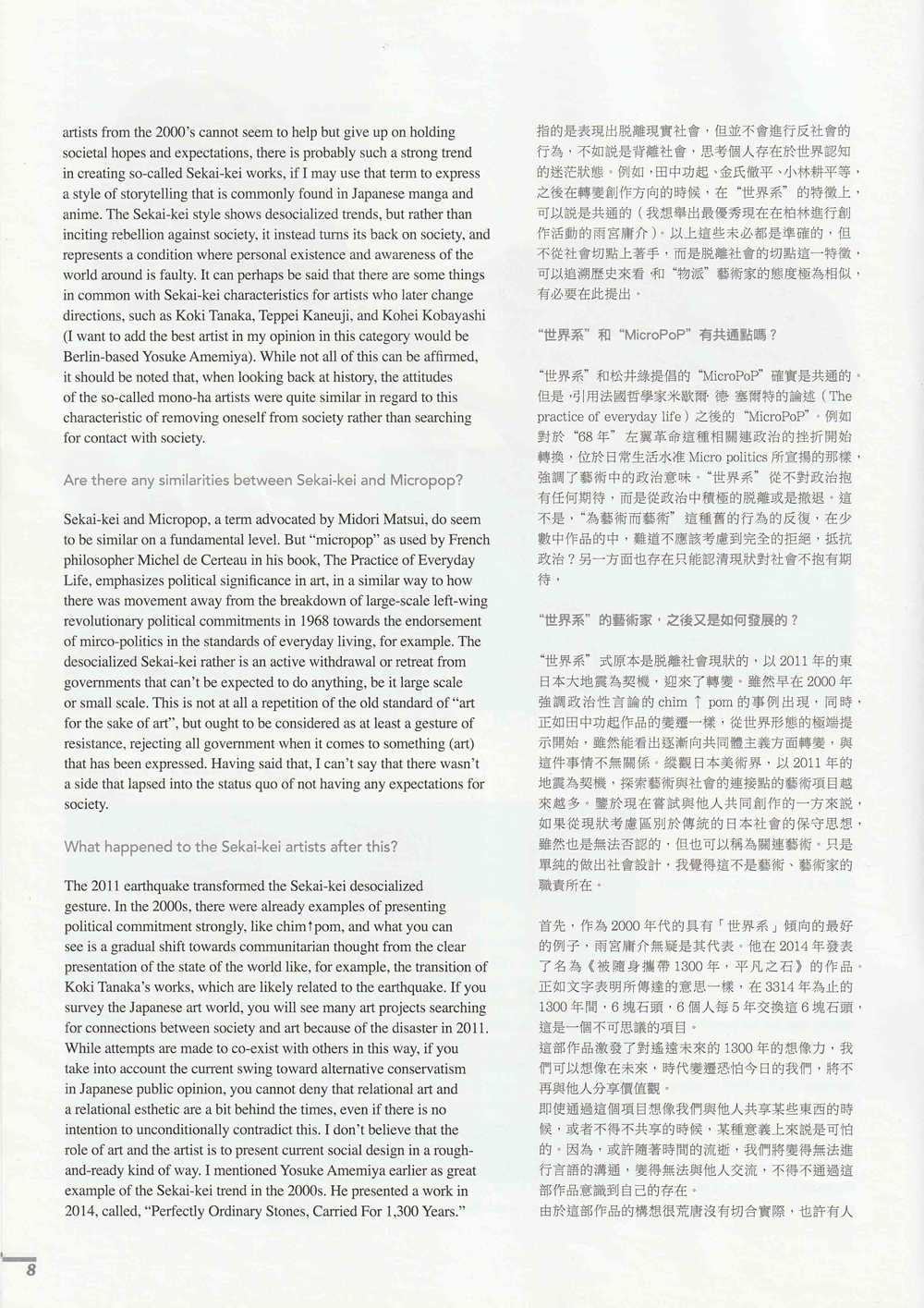
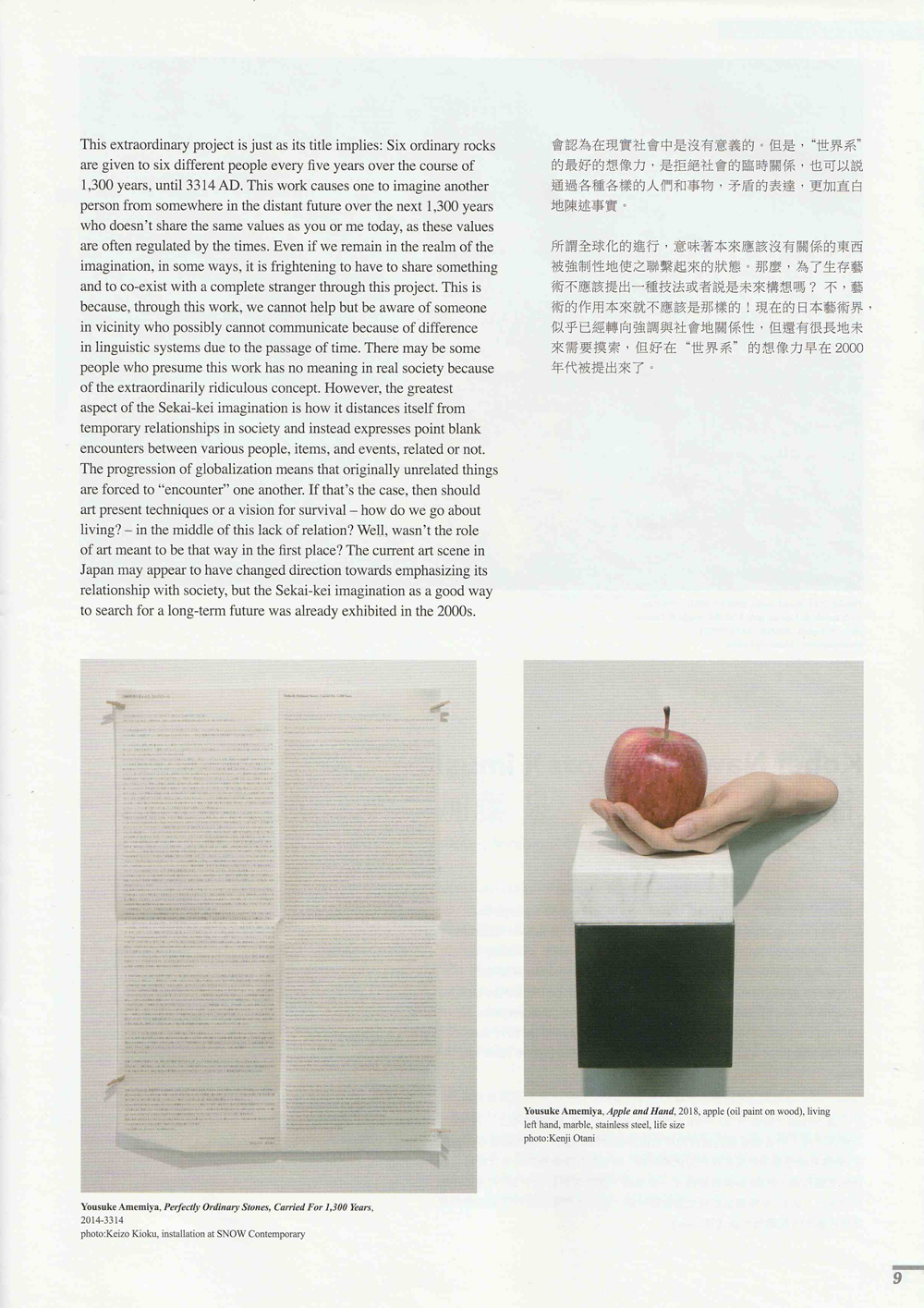
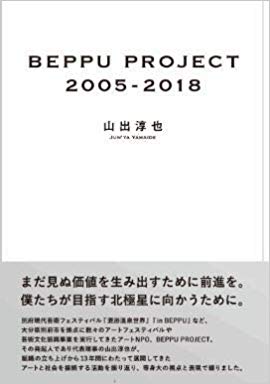
BEPPU PROJECT 2005-2018
山出淳也さんの本に、参加した国東半島芸術祭の事や「1300年持ち歩かれた、なんでもない石」の事が書かれています。
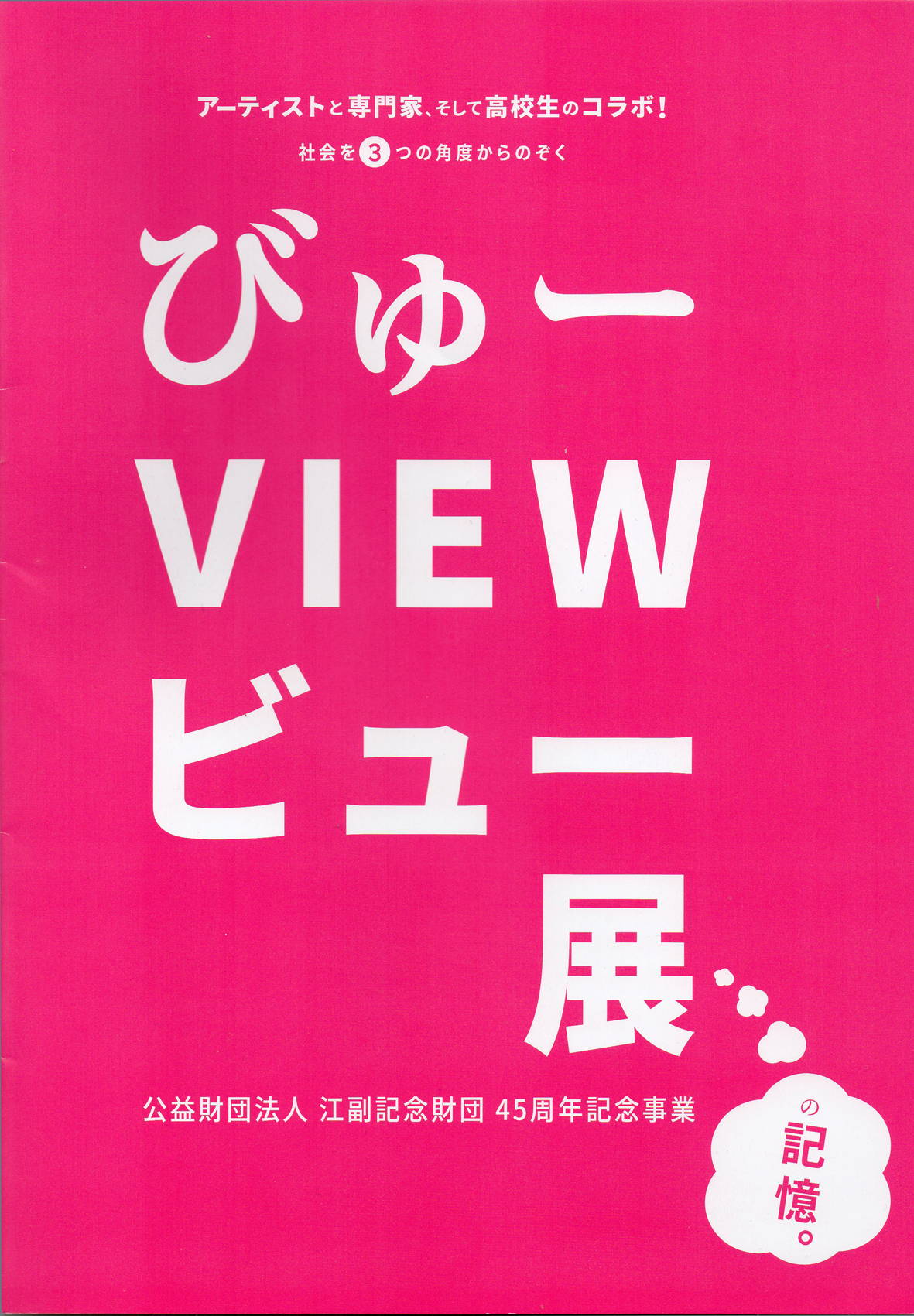
Catalogue "View 3"
Leaflet for group exhibition with high school curators, Tokyo Japan 2018
Essayed by Arata Hasegawa
Not for sale
[Long interview by high school curators (only Japanese)]
http://view3.info/yomimono/amemiya-1/
http://view3.info/yomimono/ayemiya-2//
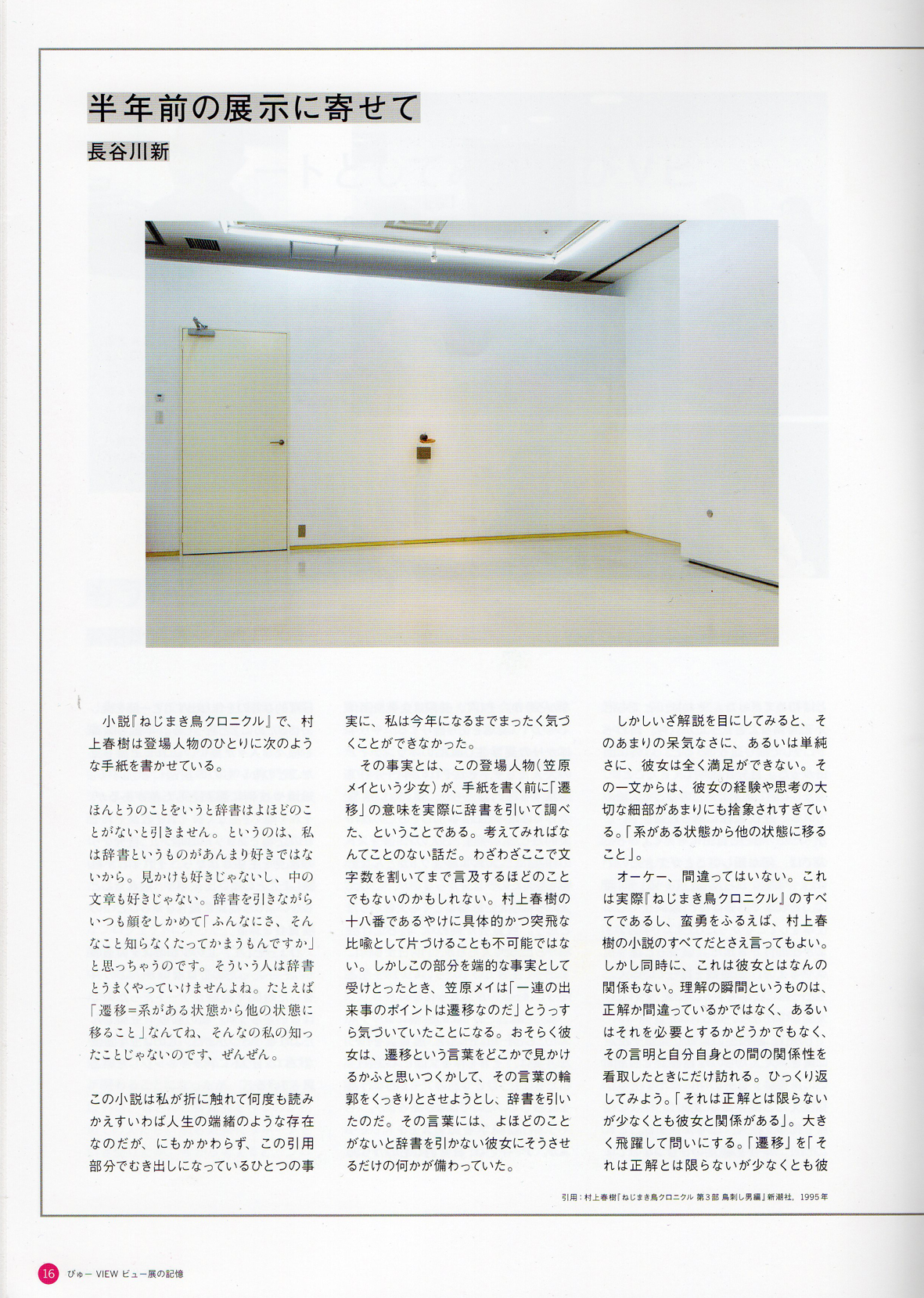
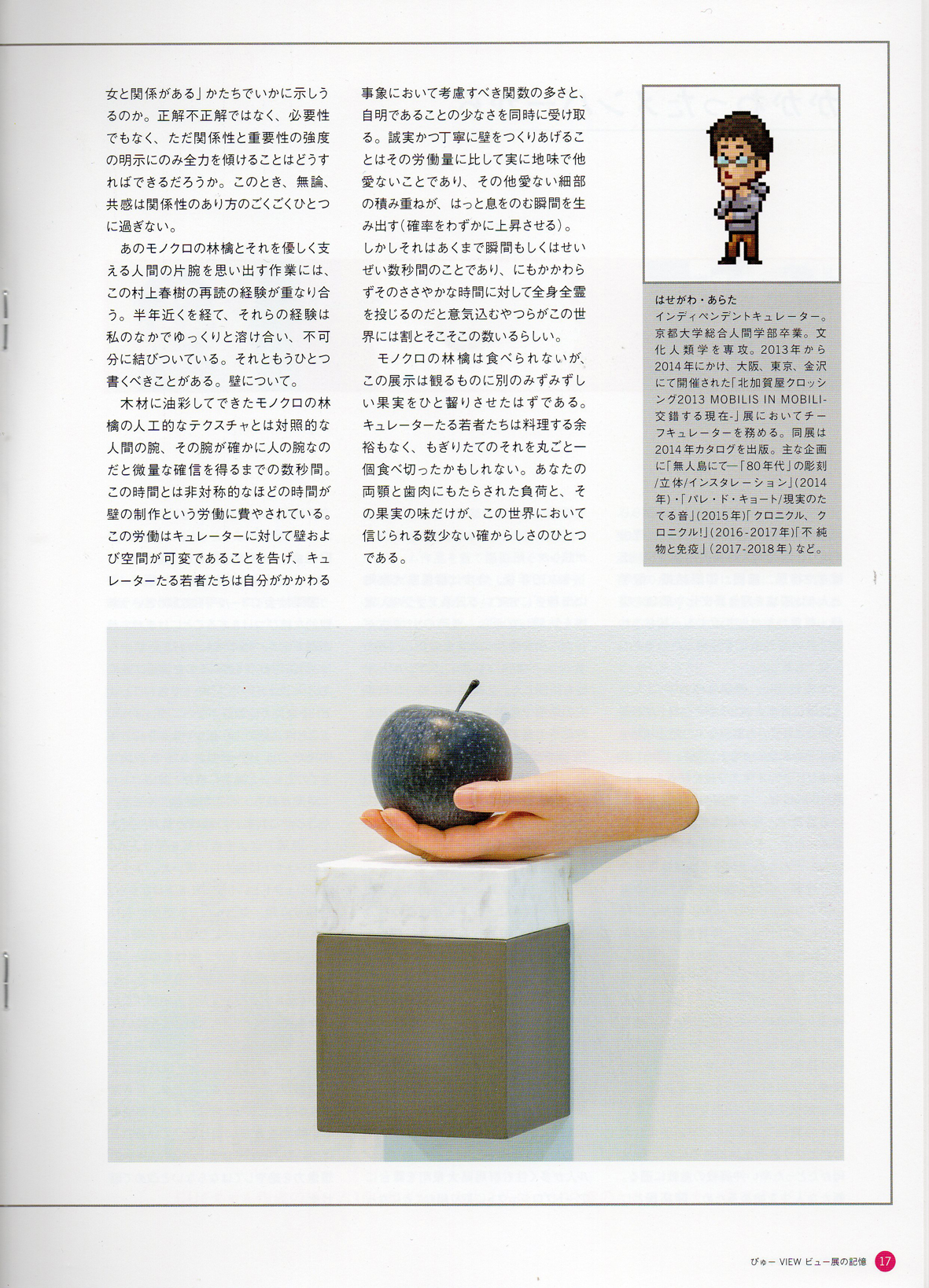
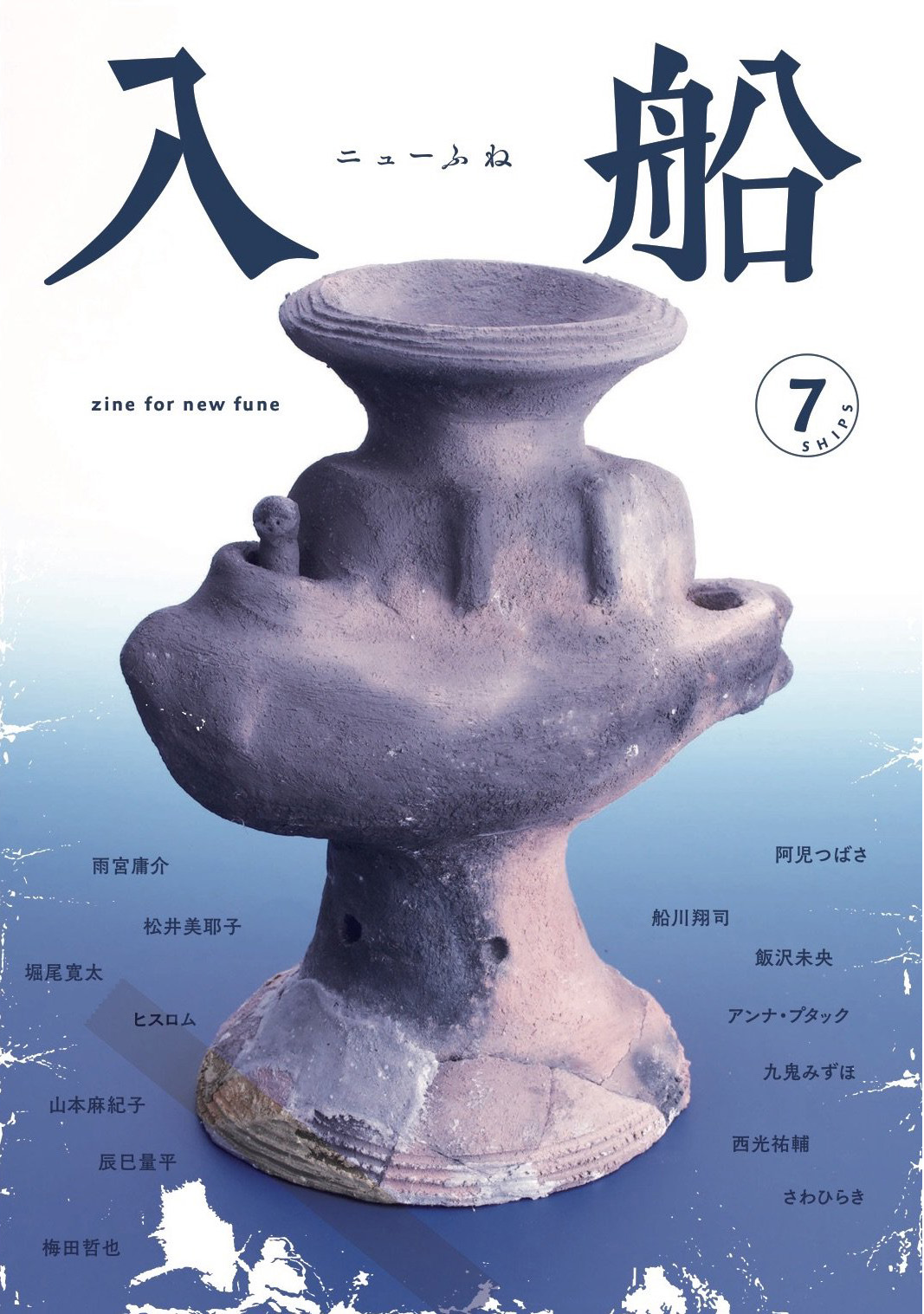
Zine/Japanese
阿児つばさ、雨宮庸介、アンナ・プタック、 飯沢未央、梅田哲也、九鬼みずほ、さわひらき 、辰巳量平 、田中有紀、西光祐輔 、hyslom、船川翔司、堀尾寛太、松井美耶子、山本麻紀子、柳本牧紀
阿児つばさ、雨宮庸介、アンナ・プタック、 飯沢未央、梅田哲也、九鬼みずほ、さわひらき 、辰巳量平 、田中有紀、西光祐輔 、hyslom、船川翔司、堀尾寛太、松井美耶子、山本麻紀子、柳本牧紀
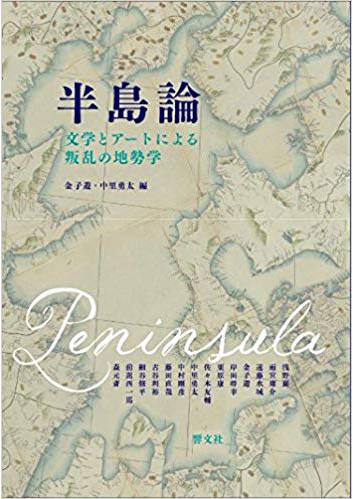
15 September, 2018
半島論 文学とアートによる叛乱の地政学
浅野麗 雨宮庸介 遠藤水城 金子遊 岸田将幸 栗原康 佐々木友輔 中里勇太 中村剛彦 藤田直哉 古谷利裕 細谷修平 前嵩西一馬 森元斎 (著) 金子遊 中里勇太 (編集)
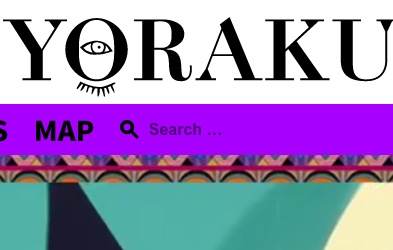
YORAKU by Kei Kitagawa
about the Amemiya's solo show at SNOW CONTEMPORARY
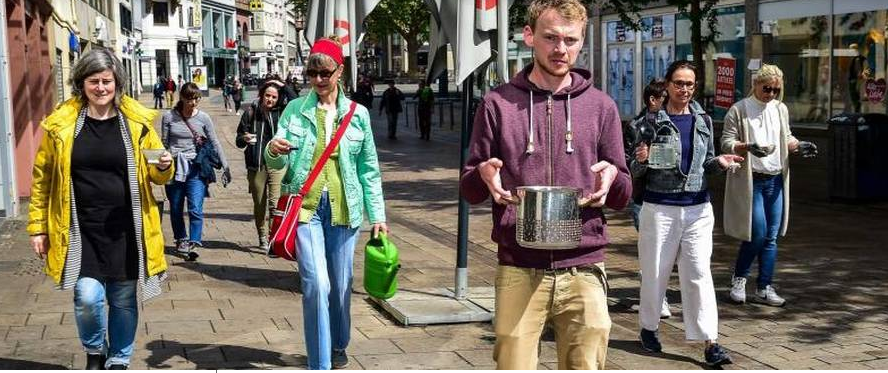
Wormser-Zeitung/ Wasser für die City-Passage
Von Birgitta Lamparth
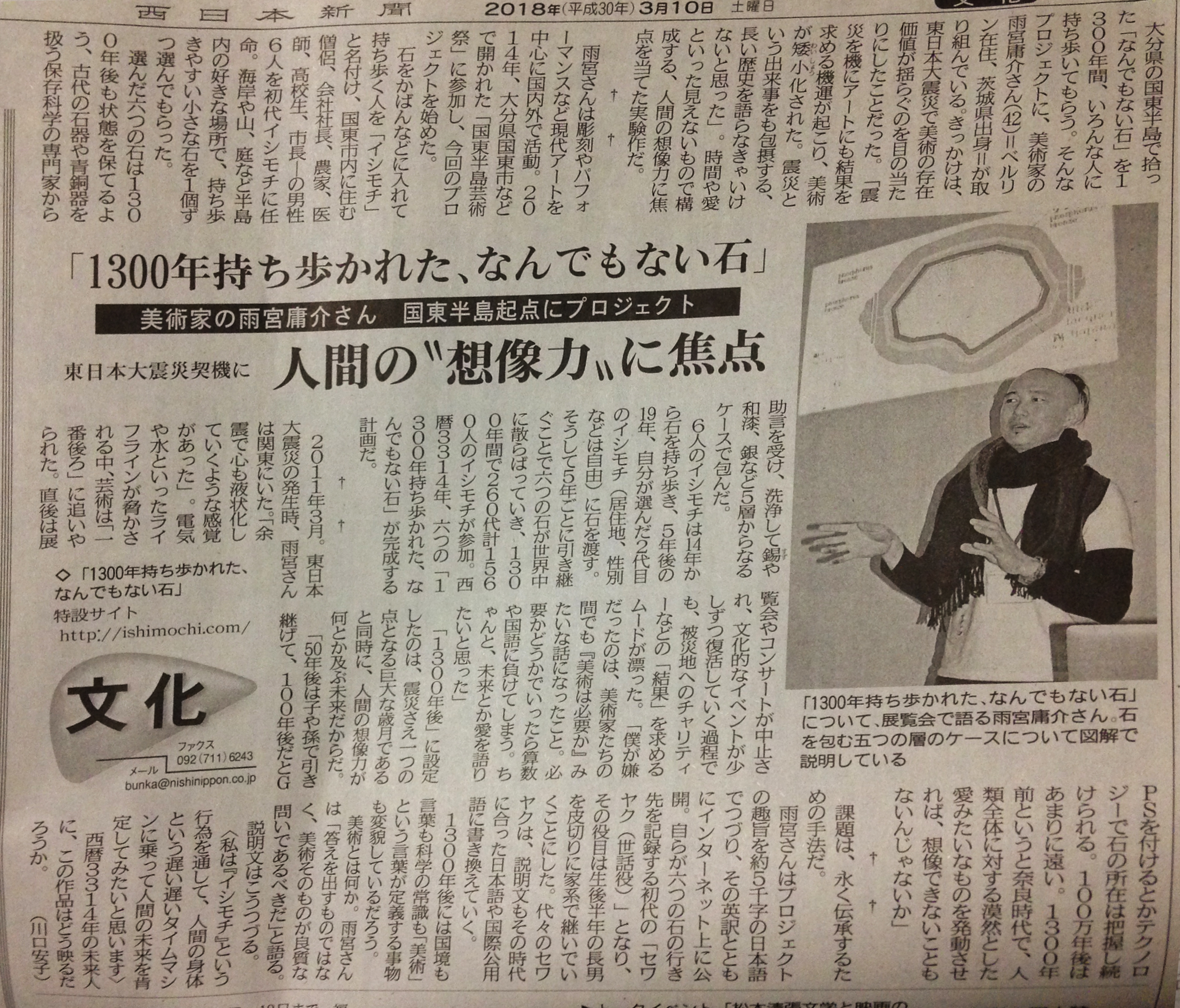
10 March, 2018
「人間の"想像力"に焦点」by Yasuko Kawaguchi
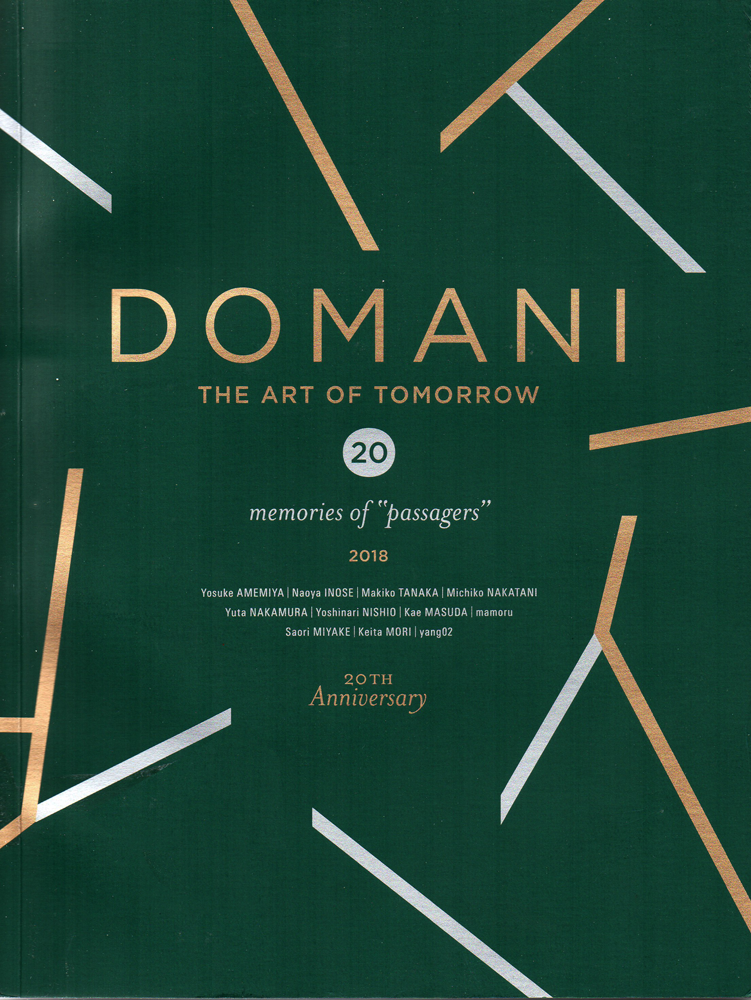
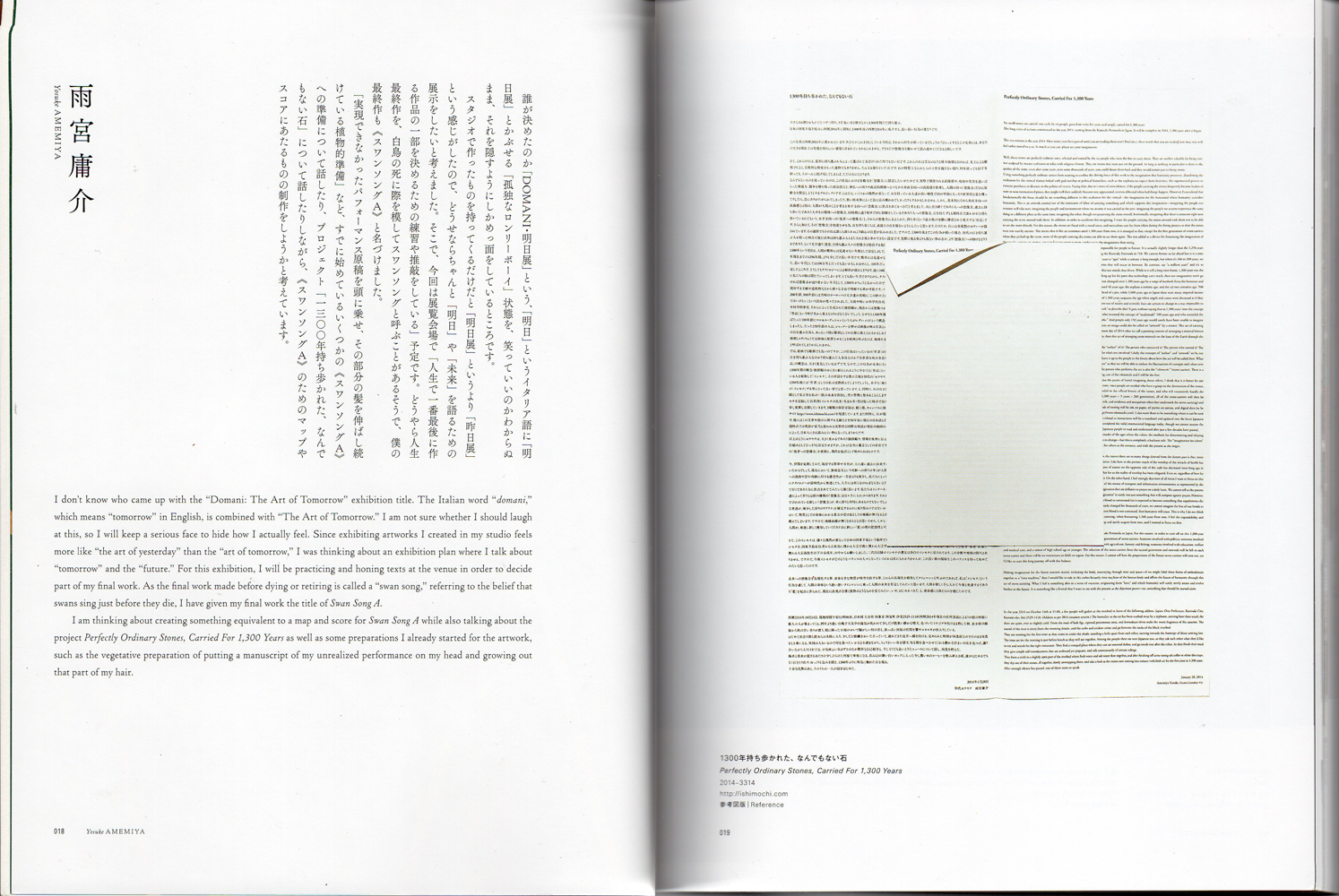
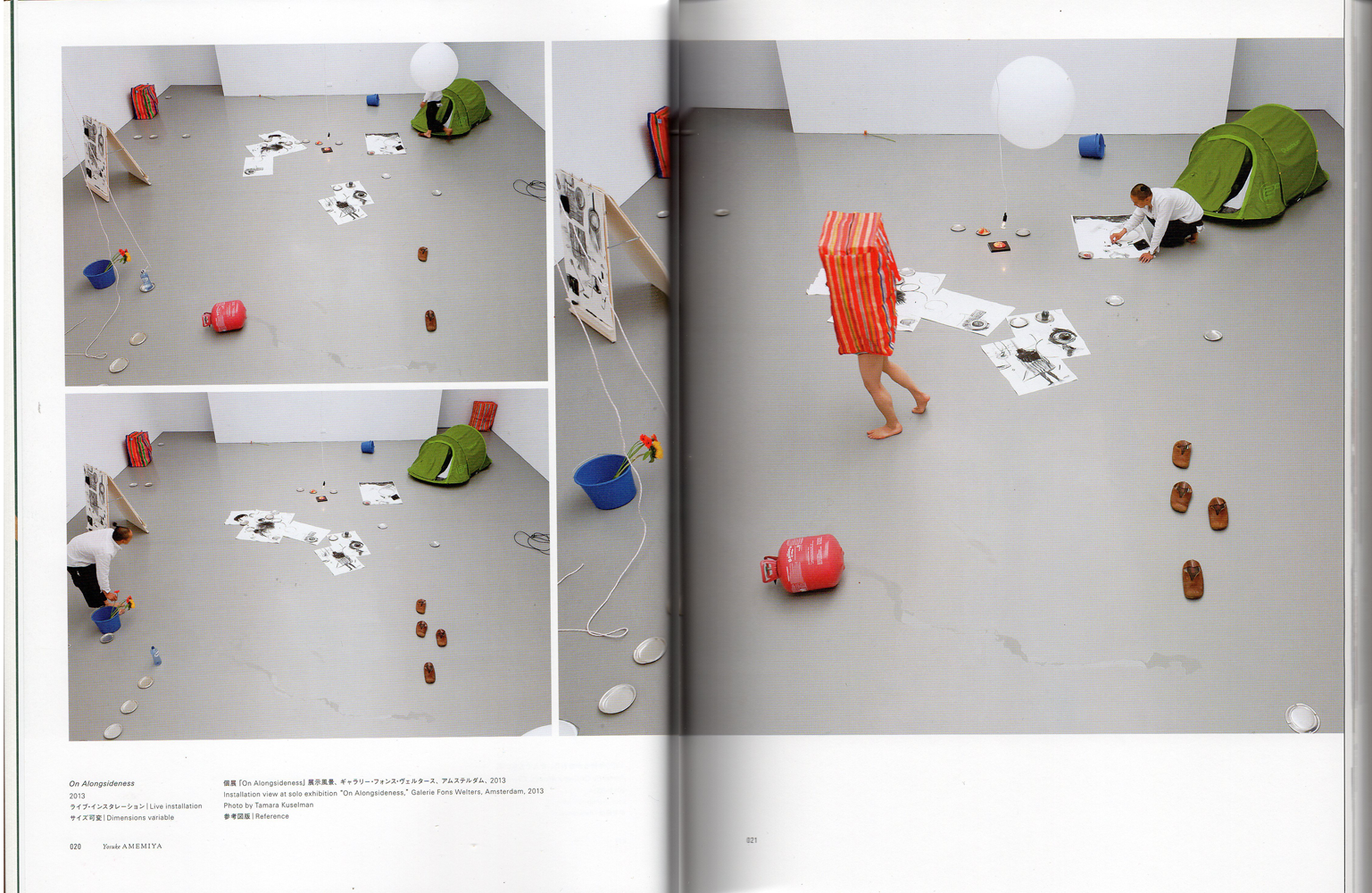
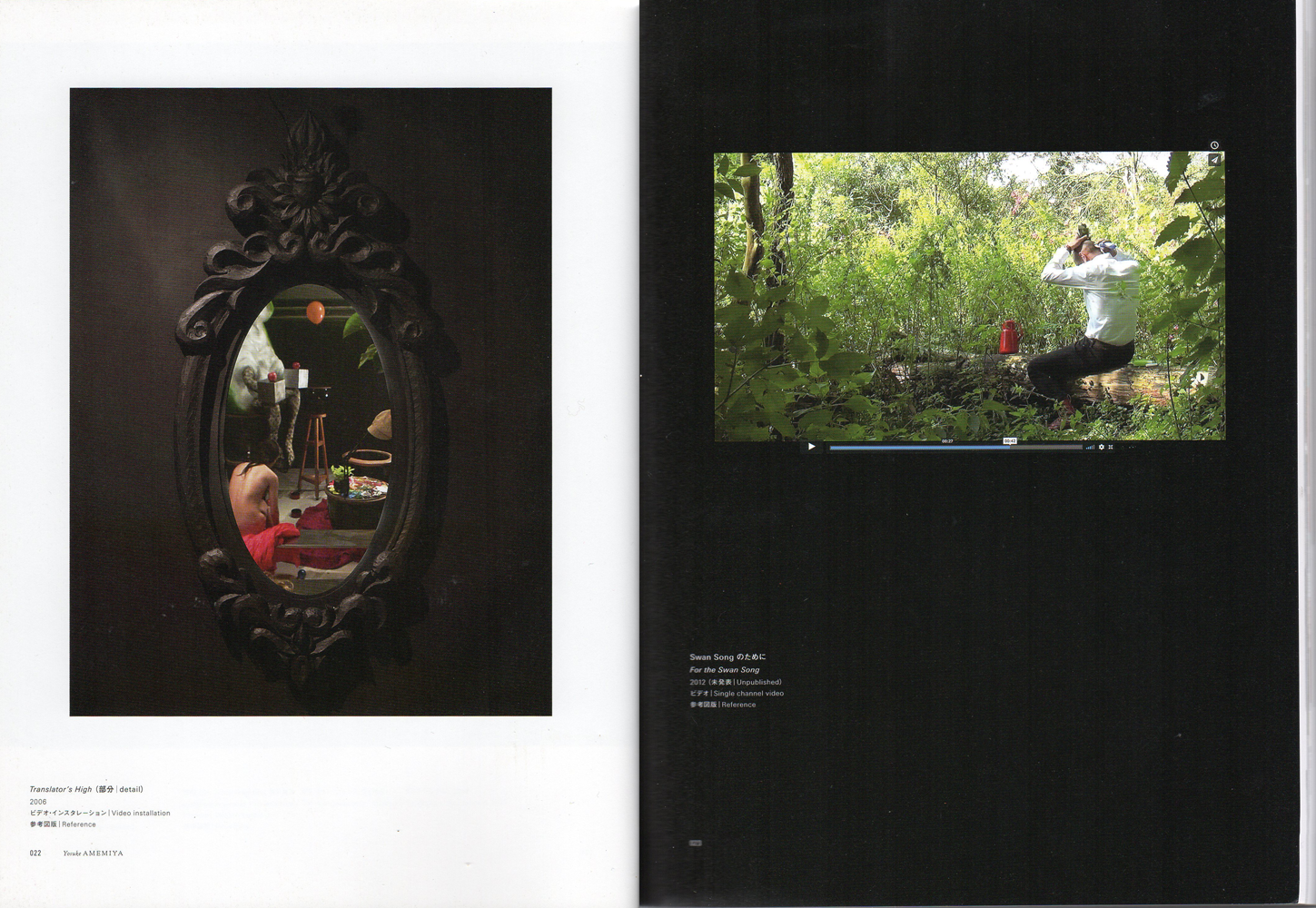
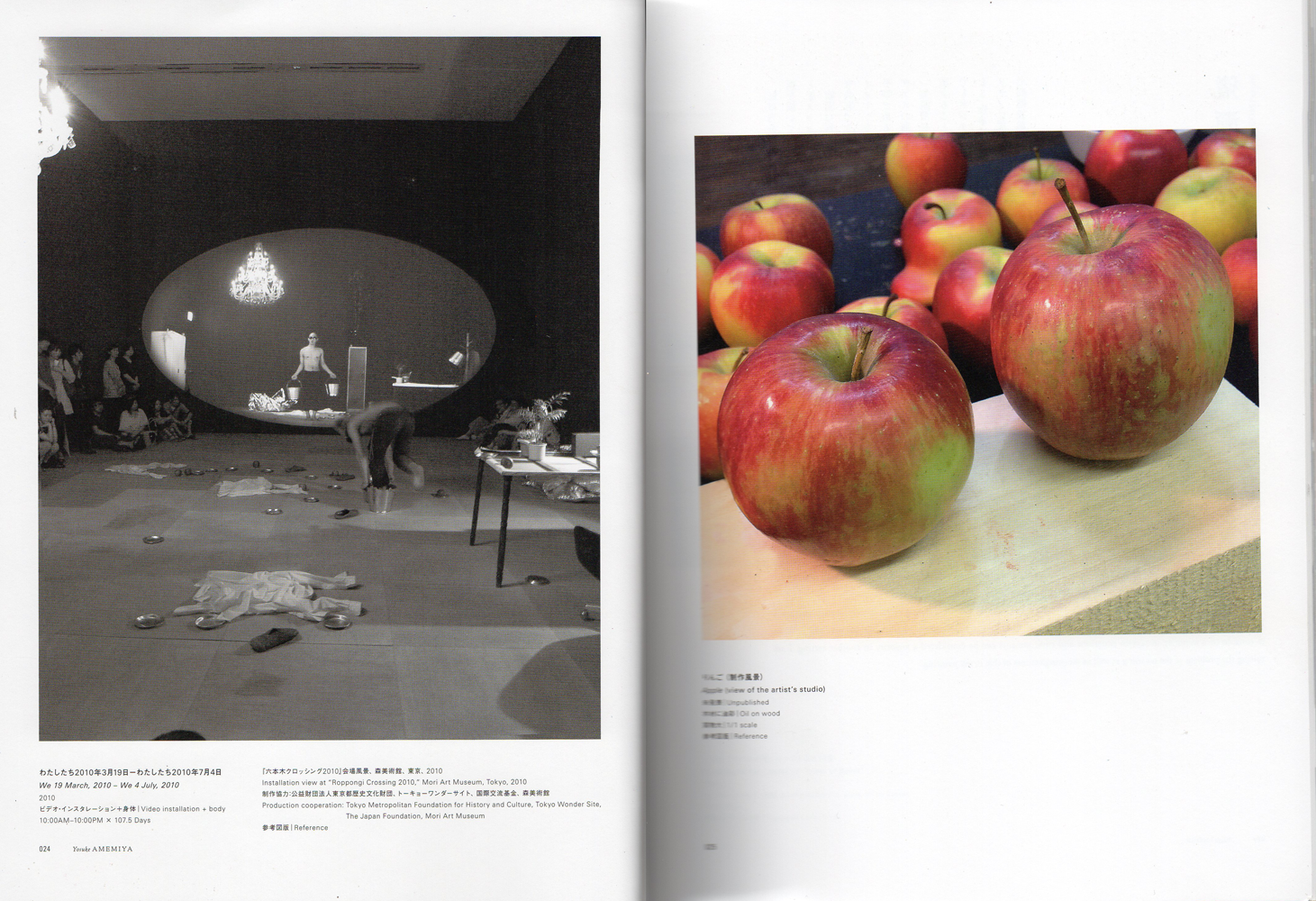
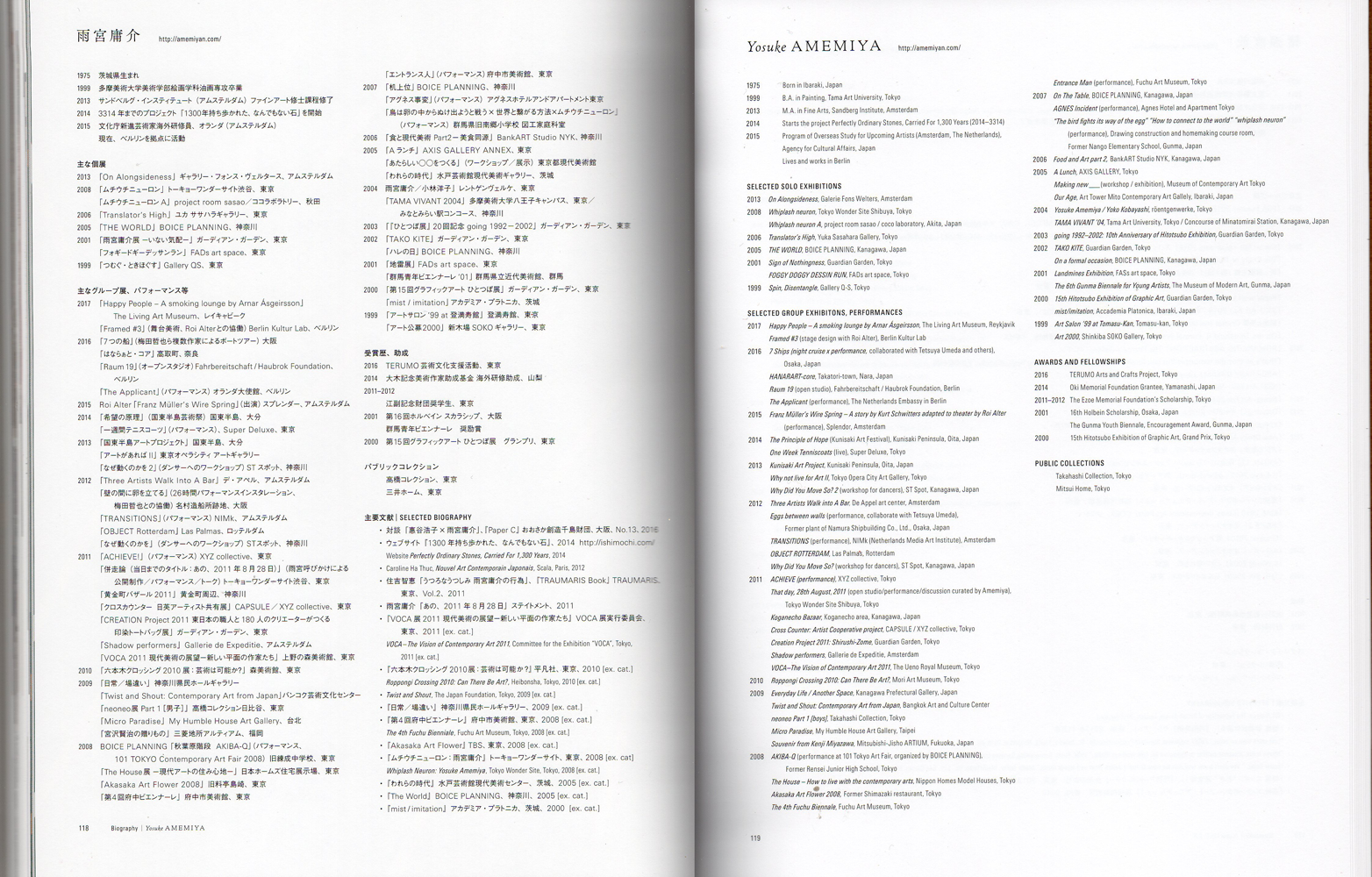
Catalog Jan 2018(JP/EN)
Published by Agency for Cultural Affairs, Japan
Supervised by Yoko Hayashi (Agency for Cultural Affairs)
Edited by 内田伸一Shinichi Uchida, Art Venture Office SHOU
Design direction: 見増勇介Yusuke Mimasu (yusuke mimasu design)
Design: 見増勇介Yusuke Mimasu, 竹内敦子Atsuko Takeuchi (yusuke mimasu design)
Translation: hanare x Social Kitchen Translation
Printing: Kowa Printing Co.,Ltd.
Edited by 内田伸一Shinichi Uchida, Art Venture Office SHOU
Design direction: 見増勇介Yusuke Mimasu (yusuke mimasu design)
Design: 見増勇介Yusuke Mimasu, 竹内敦子Atsuko Takeuchi (yusuke mimasu design)
Translation: hanare x Social Kitchen Translation
Printing: Kowa Printing Co.,Ltd.
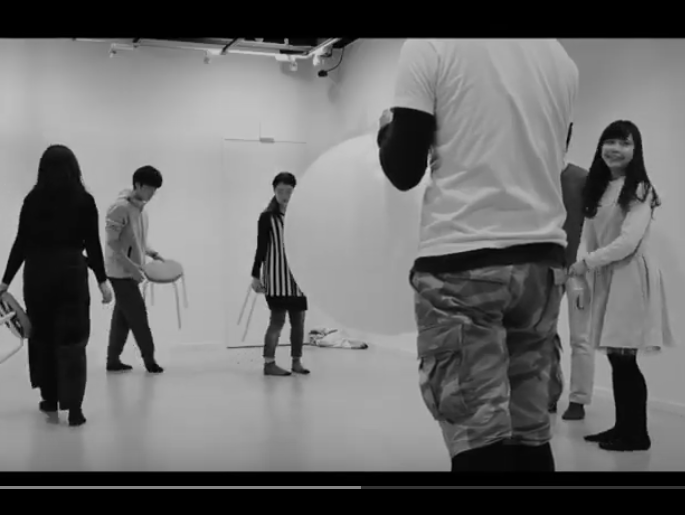
by high school students 高校生によるロングインタビュー
http://view3.info/yomimono/ayemiya-2//
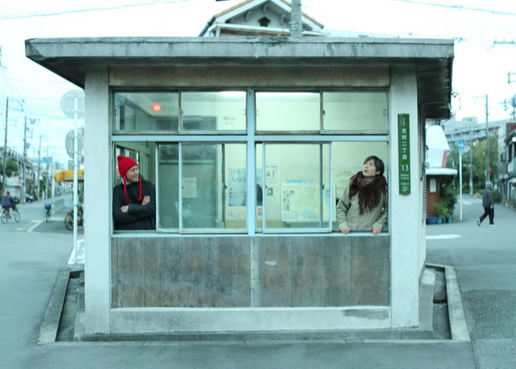
OURS. (JP)
with Tetsuya Umeda 01 http://ours-magazine.jp/walkandwatch/umeda-amemiya-01/
with Tetsuya Umeda 02 http://ours-magazine.jp/walkandwatch/umeda-amemiya-02/
with Tetsuya Umeda 03 http://ours-magazine.jp/walkandwatch/umeda-amemiya-03/

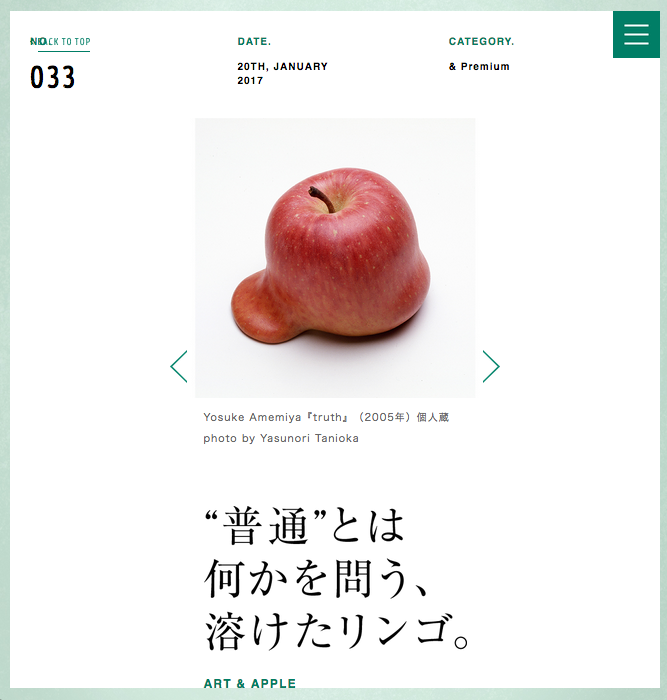
&&PREMIUM, Magazine House(JP)

〈B術の生態系〉Bな人のBな術(JP)
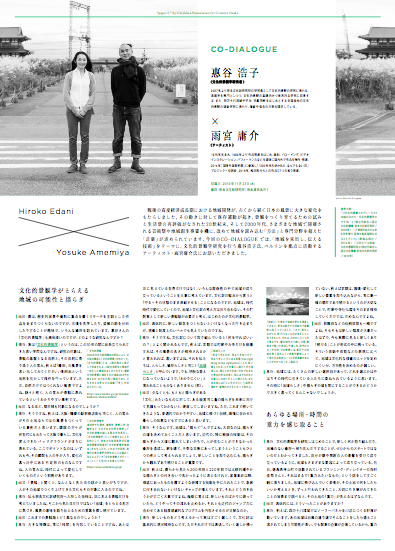
PaperC(JP)
conversation with Hiroko Edani (Cultural Landscape Section, Nara Cultural Properties Research Institute)
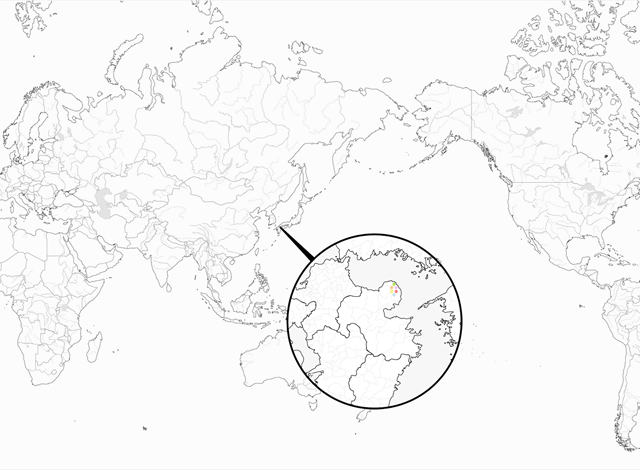
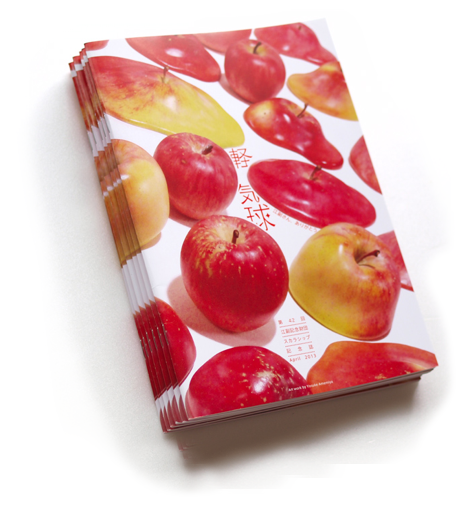
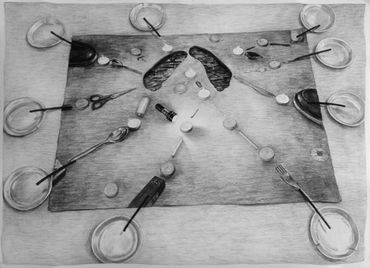
Galerie Fons Welters is proud to announce the second chapter of Yosuke Amemiya’s exhibition ‘On Alongsideness’, which is part of the Sandberg Institute graduation ‘Festival of Choices’. In his (video) installations and performances, Amemiya seems to breathe life into the everyday objects that surround him through a ritualistic approach that is at once estranging and strangely clear. In the last year Amemiya focused on creating an extensive series of charcoal drawings – 107,5 in total – in which the elements from his performative installations return to recreate his untouchable parallel universe. The motifs in the drawings range as widely as their style: abstract blurs or fine delicate lines; a whirlwind of movement or a still life of daily necessities and elements from his performances. For the first time .. of this ongoing drawing series will be presented in the front space of the gallery; while the different motifs return in real life in a constellation – or perhaps still life – based on his performance on the 4th of July in the gallery. In his drawings as in his performative installations, Amemiya melts divisions between subject and object, intersecting each other little by little as timelines run alongside the many parallel narratives.
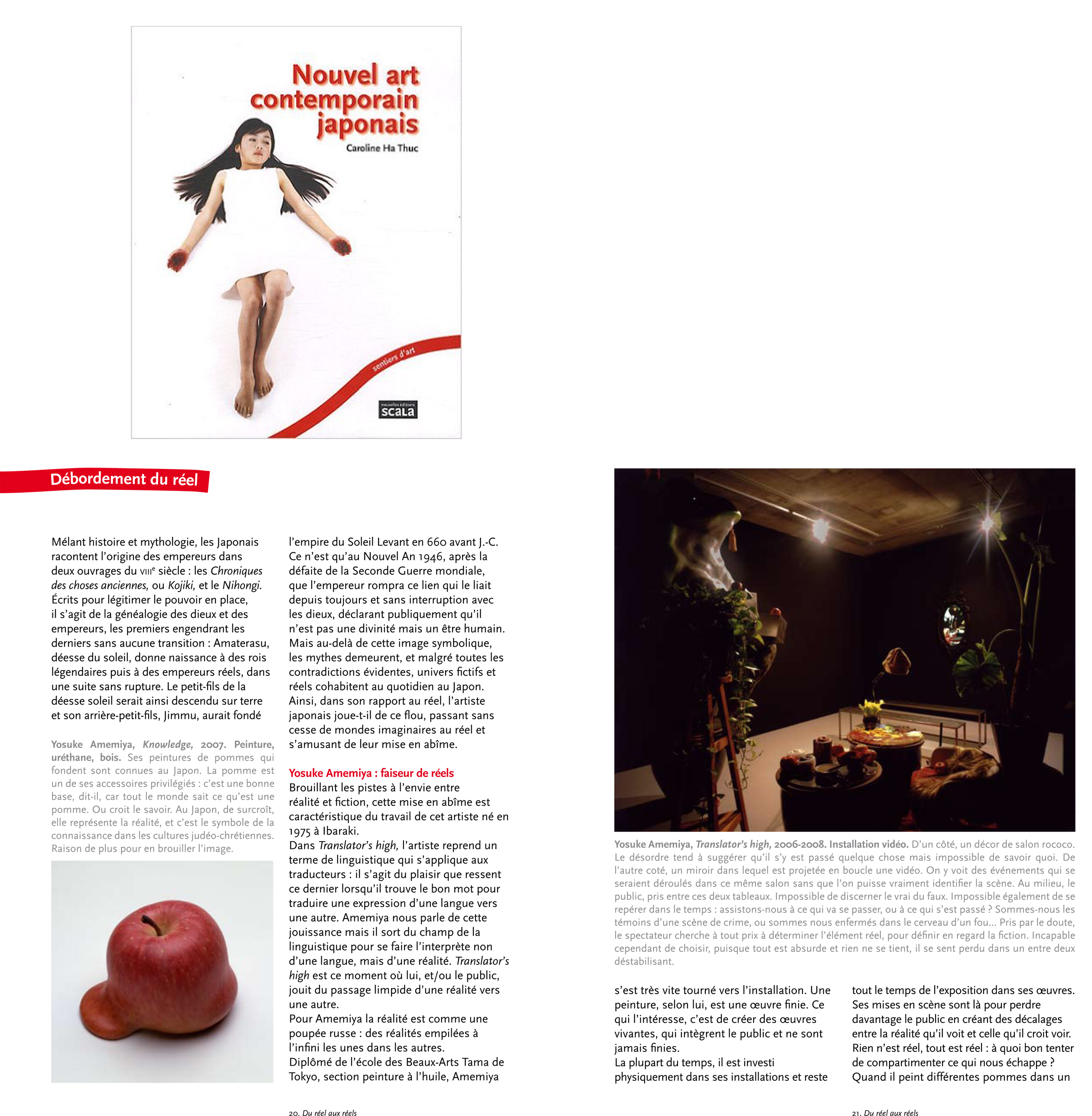
Nouvel Art Contemporain Japonais
Text:Caroline Ha Thuc
https://www.amazon.fr/Nouvel-contemporain-japonais-Caroline-Thuc/dp/2359880586
https://www.amazon.fr/Nouvel-contemporain-japonais-Caroline-Thuc/dp/2359880586

TRAUMARIS|BOOK VOL.2
Text: Chie Sumiyoshi Photo:Sai
http://traumaris.jp/book2/index.html
http://traumaris.jp/book2/index.html
"That day, 28 Aug 2011"(the title has changed just after the day performed, to "On Alongsideness")
I heard the series of exhibition at Tokyo Wonder Site has changed by the disaster caused by the earthquake Then I got a request to do something.
Needless to say, the disaster on 11 March, 2011 has given enormous damages for and/or to the people such as force to dispossess tremendous property and lives.
The disaster made the Japanese people change their values, brought a fact to light, threw the people into despair, and showed a beam of hope at the same time.
Again, it was so abominable, I strongly hope that it would never happen again. On the other hand, I can't stop my avid feeling, more of like zealous, because of the effect of the earthquake. I thought the effect, changing people's values, brought facts to light, threw the people into despair, and showed a narrow beam of hope at the same time, should be provided by an experience of art, not the disaster, that's why I wrote "jealousy" even if these words were strongly misleading.
"Is art necessary?" appeared to be very a trivial question to people after the disaster. I think it's kind of an unfair attitude because there was a non-existing type of the question, because the correct question should be "Is art important?". Both words, necessary and important are sounds like similar in appearance but quite different.
Especially after the disaster, people don't have any time to keep company with an insincere games or bored plume works.
Only involving in works which include putting their body as guarantee, knowing both the meaning of the questions "why do you make" and "why do you show it" will get common persuasiveness. Thus I asked some artists, art documentarist, critics, they exactly have the same attitude to share on the time of this event. I think all of them are supposed to be correct, but it should be more precise when this event comes to an end.
I hope you could find a new classification as not like painting, photograph, performance, sound art, sculpture, etc. If I succeed picking out "as posture of a painter in front of his/her work in the studio” , this show will start to run alongside with the present time including your life time. Then it could say that “a performance with a life" or "a performance is a life" also "a life is a performance".
I hope this event would help find a brand new map about your life / all of your works / the category in your thought.
Does someone want to look around the world with the "new map" in your hand?
Yosuke Amemiya (Proposer for the event, Artist)
「あの、2011年8月28日」(当日以降にタイトルは「併走論」に変わります)
今回のトーキョーワンダーサイトの展示は震災によって大きく変更されて、今に至っていると聞かされた。
その中で僕にも「何かやってくれ」と依頼が来た。
言うまでもなく3月11日に起きた今回の震災は多くの人命と財産を一瞬で奪い去った忌むべき出来事だ。
同時に、震災は従来の価値観をいともたやすくひっくり返し、暗部を明るみに出し、膨大な絶望を投下し、ついでに少しの希望を与える事さえした。
かなりの語弊はあるが、それ、芸術がやりたかったエフェクトじゃないか?。僕が作品でいつかやりたかったエフェクトじゃないか?。僕は震災以来、どこか震災そのものに嫉妬しつづけている。
震災直後にたくさん聞こえてきた「芸術は必要か?」という問いは、震災以前にもそんな問いは成立してはいなかったという意味でとても卑怯で、いつの時代も「芸術は重要か?」が正しい問いなはずだ。「必要」と「重要」は似て非なるものだ。
震災を経て実感する事は、人々のある種のリテラシーレベルが上がっている事だ。口先だけのゲームやただ借りてきたものに付き合う時間は誰にも存在しなくなってしまった。自らの身体を担保に、作品を作る意義とそれを人に見せる意義、そのどちらの意義について理由を開示しながら制作する。そんな手つきだけが説得力を有するようになったように思える。
僕は思い立って「身体を伴って作品と併走している、それが妙なシークエンスを思い描かせる」そんな作り手数人に声をかけさせてもらった。公開制作と呼んで良いのかどうかわからないが、その「画家が絵の前でとる構え」みたいなものを抽出し、それ自体が現在と併走をはじめたら、きっと絵画・彫刻・写真・音楽・パフォーマンスとか、そういったカテゴリーでは捉えられない、新しい腑分けが斜めに一本見通せるはず。そこで手に入れた新しい地図を持ち、改めて世界を見渡したいと思うのは僕だけではないはずだ。
2011年夏
雨宮庸介(呼びかけ人)

VOCA - The Vision of Contemporary Art 2011
The Ueno Royal Museum, Tokyo
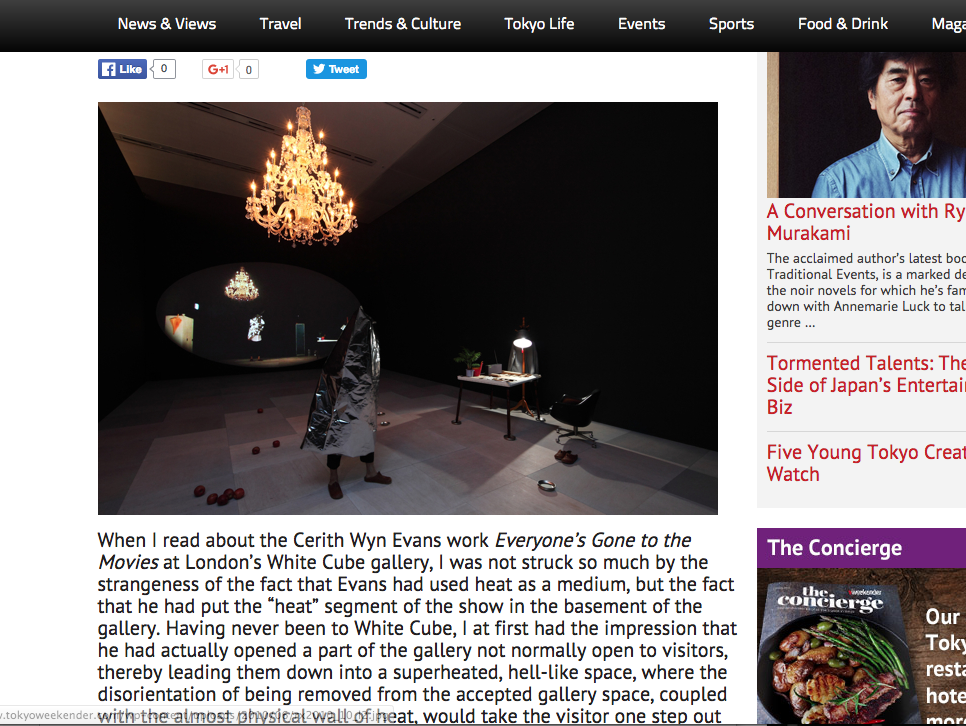

Roppongi Crossing 2010: Can There Be Art?
Mori Art Museum, Tokyo
Text:Katsura Kunieda
http://www.mori.art.museum/english/contents/roppongix2010/index.html
Text:Katsura Kunieda
http://www.mori.art.museum/english/contents/roppongix2010/index.html

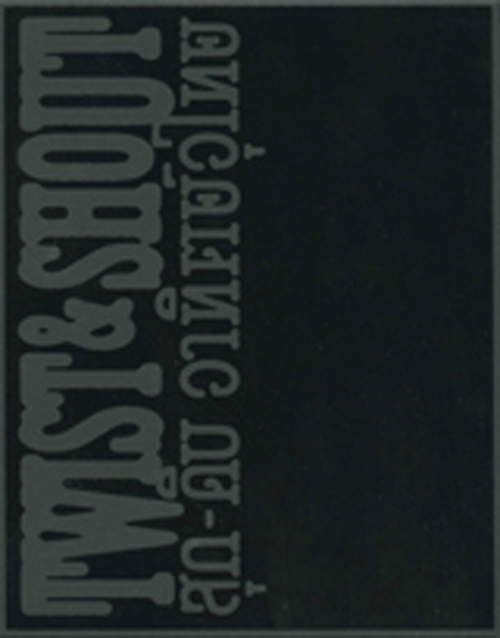
Twist and Shout, BACC, Bangkok
Text:Kenji Kubota
http://www.jfbkk.or.th/art_culture_20090922.php
http://www.jfbkk.or.th/art_culture_20090922.php
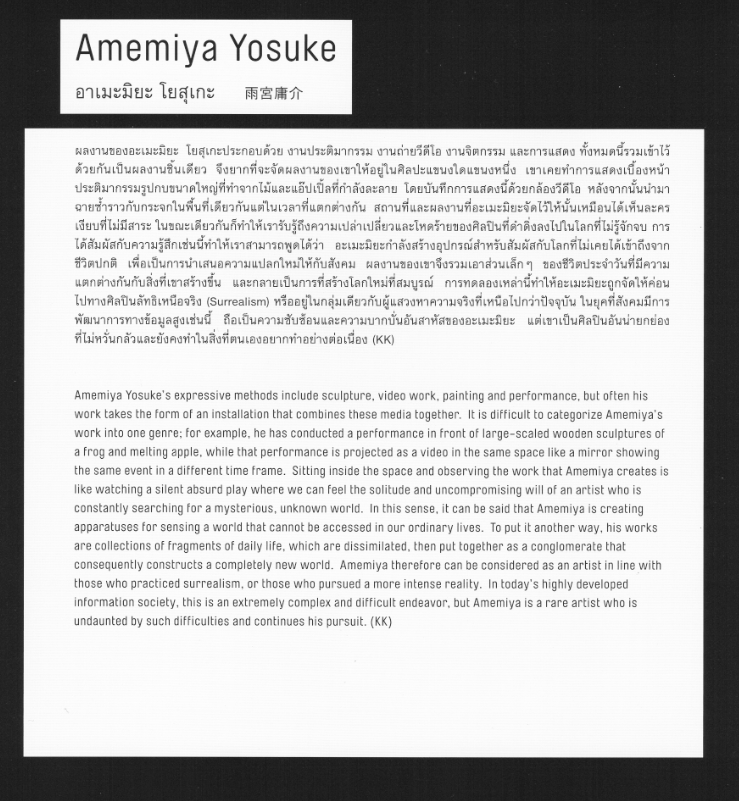
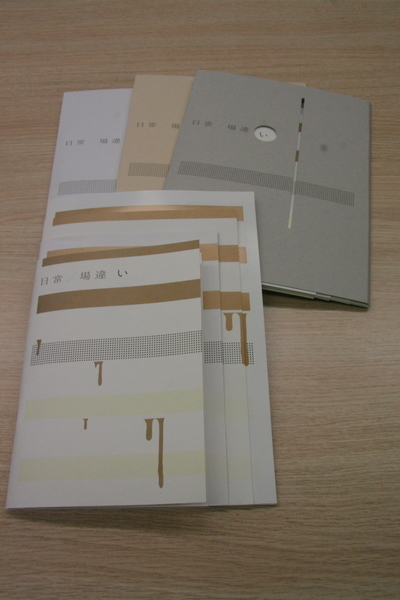
雨宮庸介の「場違い」
こちら側の部屋でも、あちら側の部屋でも時間は同じように
均一に経過している。両者は同じ時間性の中にある。
村上春樹『アフターダーク』講談社文庫 2006年刊 132頁
「日常/場違い」展。雨宮庸介の展示室。表から見ると周りは、白い壁に囲まれている。壁には唯一、室内への入口として小さな扉がある。扉をそっと開け中に入ってみる。そこは暗い部屋だ。目を凝らしあたりを見る。ロッカーが置いてある。10人くらいの社員がいる小さな会社の引越し。新たな事務所に運ばれるまで、一時的に倉庫に保管されているかのように、これらのロッカーはあちらこちらを向き無造作に置かれている。振り返ってみるとロッカーの扉が1つ開いている。この部屋に入るときに自分が開けた扉だ。部屋の中から見るとそれはロッカーの扉なのだ。つまり自分は、ロッカーの中を通り抜けてこの世界に入り込んだ。部屋の壁の1面にスクリーンがある。スクリーンには、今自分がいる部屋と同じ部屋が対称的に映し出されている。部屋の中のロッカーを数えてみる。11個だ。映像の中にもロッカーが11個。22個のロッカーがこの空間にある。
スクリーンを見ていると、ロッカーの扉を開けて男が現れた。自分が立っている実世界と映像で作られた「向こう側の世界」。この2つの世界が向き合う1つの空間に自分と男、2人がいる。男は水泳で使うゴーグルをつけている。ゆえにこの男の表情は極めて分かりにくい。仮にこの人物を「ゴーグル男」と呼ぼう。上半身裸のゴーグル男は、金物のバケツを持っている。そして、バケツに入った水を別のバケツに移す行為を続ける。突然、画面が変わる。今度は、オレンジ色の大きな袋を頭からすっぽりとかぶり、袋からにょっきりと生えた足しか見ることのできない奇怪な人物がロッカーから現れた。この人物を「袋小僧」と呼ぶことにする。袋小僧は、部屋の中を徘徊し、立ったり座ったり忙しない。またもや、画面は変わり、ゴーグル男のシーンに戻る。スクリーンには、これらのシーンが繰り返される。映像をじっくり見てみる。すると自分は生身の人間であり、ゴーグル男と袋小僧や他の登場人物は映像上の存在であるという境界が次第に薄れていく。ここには、確かに自分と彼ら、「わたしたち」がいる。自分は、ロッカーに囲まれた世界でじっと繰り返される彼らの行為を見続ける。時間の過ぎるのを忘れて。いつまでもずっと。
*
雨宮庸介は、多摩美術大学卒業からこれまでにいたる自らの創作活動で、厳密な区分けはできないが2つの段階があると考える。そして本展の新作《わたしたち》は、新たな創造に展開する3期目の入口である、と雨宮はいう。
これまでの彼の作品を概観してみよう。
第1期は、1999年から2004年までと考えられる。大学の卒業前後から約5年間だ。この時期は、自然や日常に存在する事物や状況を雨宮の視点でスライドさせた作品が特徴である。初期の作品《擬態》(1999年)[fig.*]では、畳の上に背中に畳の地肌が描かれた蛙が這っている。生物が他の無生物に形態を変化させ、外敵から身を守る自然界の身体的知恵「擬態」。雨宮は、和室を使い蛙が畳に身を隠すという状況をつくり出した。そして、われわれが田畑や自然のなかで目にする蛙の姿から畳に同化する物体へと移行させて見せることで、逆説的に身を隠そうとする蛙の本来の姿を際立たせている。
第2期は、2005以降から現在であるといえる。代表作《THE WORLD》(2005 ) [fig.*]では、林檎、熊のぬいぐるみや植物を展示室に置き、鑑賞者への公開前にその空間で雨宮や裸の女性が登場するドラマが撮影される。展示室では、実際にオブジェが置かれた空間で彼らが過ごす時間と、鏡を模った画面に映される事前に撮影されたドラマの時間が同時に進行する。見ている者の時間。映像の中で進む時間。1つの空間で平行に時間が過ぎて行く2つの異なる世界は、彼らに不思議な感覚を与える。そして、彼らの側の世界には、雨宮が極めて巧緻に制作した林檎のオブジェと本物の林檎が混ぜ合わせて展示されている。多くの人々は、本物の林檎か彼が作った林檎のオブジェかということに感心を寄せる。雨宮庸介にとって、林檎が本物か否かは重要なことではない。彼は、単に外観によるものの見え方ではなく、ここにある事物がどのようにわれわれと関わっているかを問うている。実世界と映像世界が空間に共存すること。同じ関係が林檎でいうところの本物とオブジェの関係でも繰り返されていている。雨宮は、彼が作りだした事物を使って真偽の見え方の境界をあいまいにし、あえて不明瞭な状況を作り出す。そして、彼の拵えたこの状況は、世界のありようをわれわれに覚醒させようと迫ってくる。 この雨宮の手法は《ムチウチニューロン》(2008年)[fig.*]でさらに発展する。この作品の展示室は《THE WORLD》と同じような状況が設定されるが、雨宮は、この展示空間に雨宮の身体そのものを存在させた。56日間という会期中彼は、毎日林檎や水の入ったバケツを使ってパフォーマンスを行う。映像に映し出される「向こう側の世界」にいる雨宮庸介と鑑賞者とともに実世界を共有する雨宮庸介。同じ人物、とりわけ作家本人を2重に存在させることにより、彼は、われわれに展示室で目にする物体、状況、さらにわれわれの目の前にいる雨宮自身との関係をより強く求め、「世界」とはいかなるものかの問いを与える。
「『私』がどこで終わり、『私たち』がどこで始まるのか?」雨宮の命題だ。彼は、この命題をわれわれの命題としても投げかけてくる。オブジェ、インスタレーション、映像、彼の身体など様々なアイテムにより構成される雨宮の作品。その作品のなかで、アイテムとわれわれは、映像対実世界のように単一的な関係ではない。雨宮は、それら諸要素が絡み合うその合間には、曖昧な幾つもの位相があることを示し、しかもその位相の場にわれわれ自身も引き込むことで、われわれに世界を共有させようとしているのだ。
今回の新作《わたしたち》。この映像に登場するゴーグル男と袋小僧やその他の登場人物。彼らのシーンが繰り返される映像を展示空間で体感する鑑賞者。雨宮は、「A,B,A,C,A,B」という音楽の形式でいうところのロンド形式のように基本となる主題の間に異なる旋律が挿入されるようにループする映像を用いたこの作品で、鑑賞者のこれまでの視覚的経験と作品を目の前にした体感を繋ぎ合わせる。経験と体感が繋がることで、雨宮庸介が展示室でつくりだした世界を通して、単体としての「私」(鑑賞者)から雨宮とともに「私たち」という複数で成立する世界が始まる。
中野仁詞 (本展キュレーター)
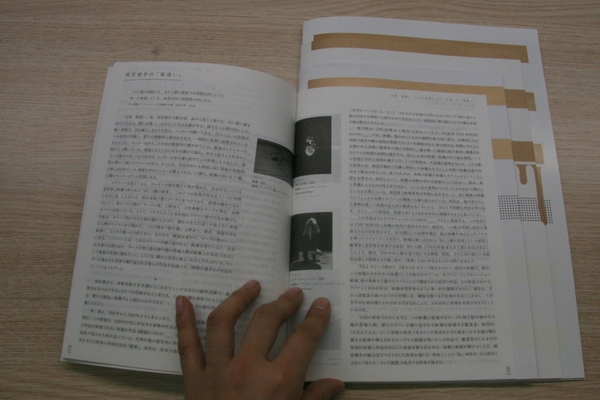
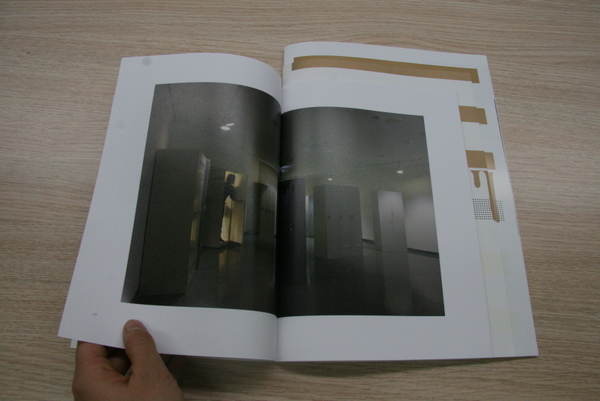

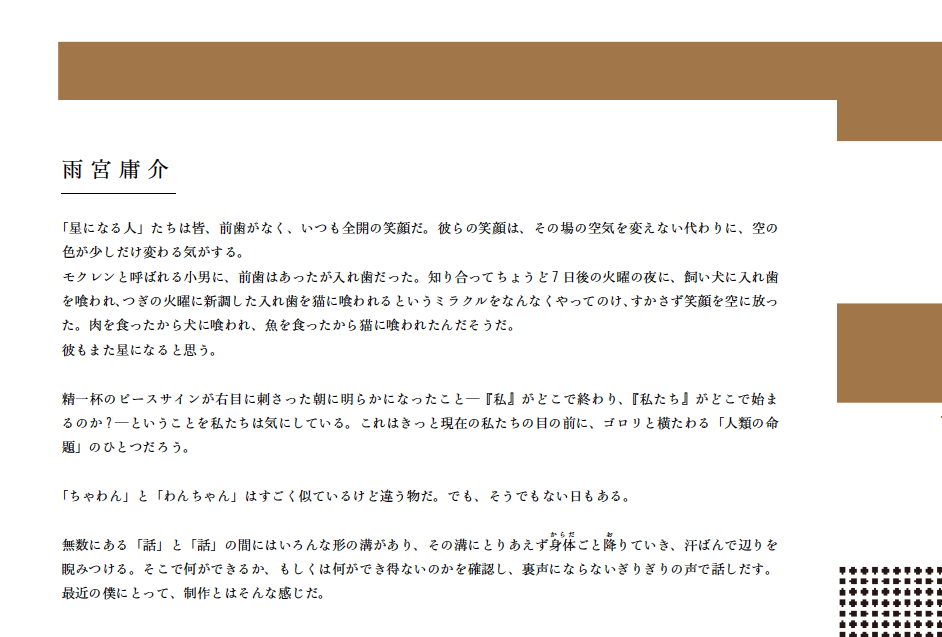

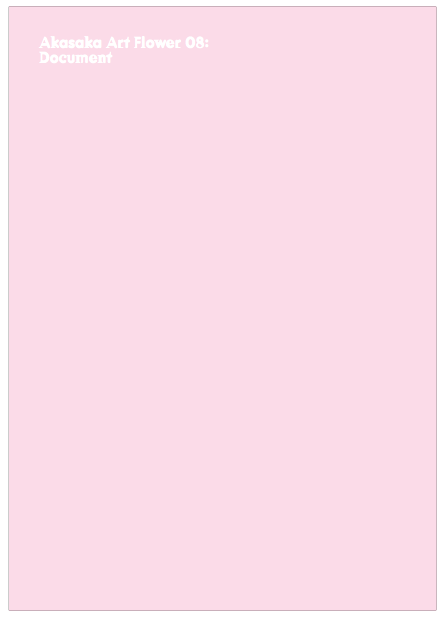
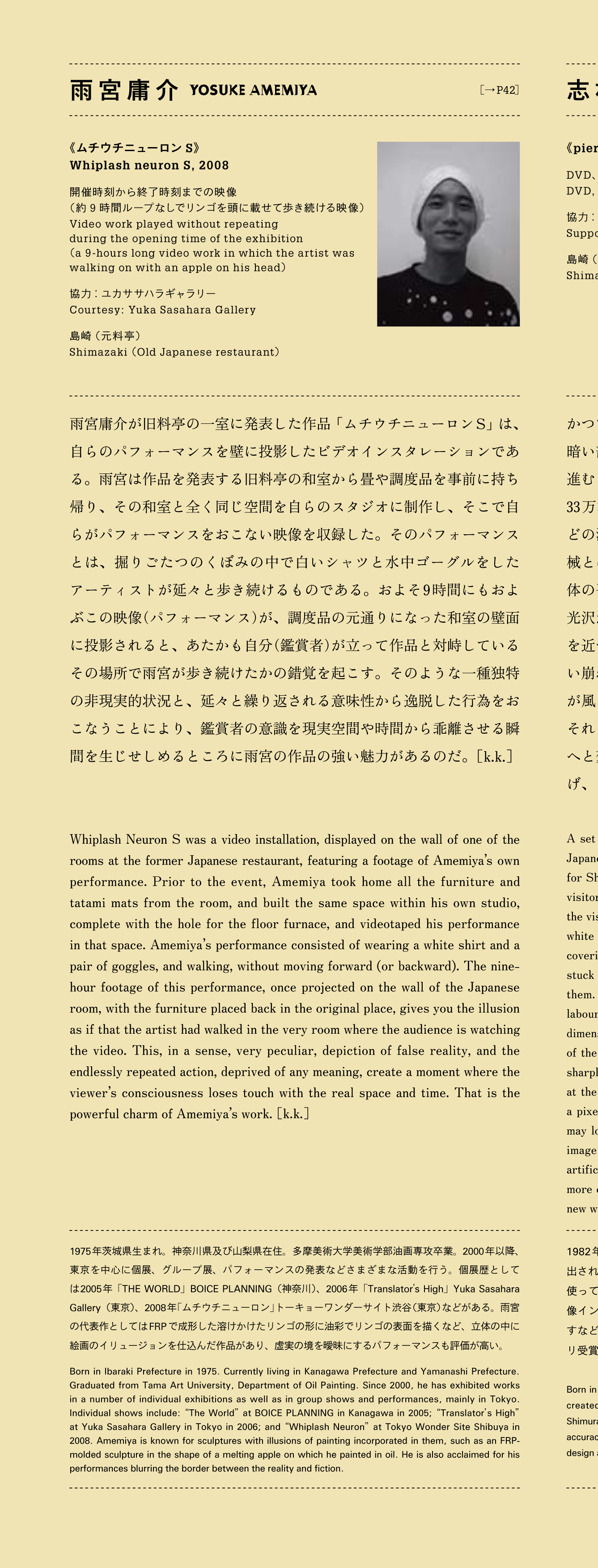
 Dec 2009 Book (JP)
Dec 2009 Book (JP)
BT exhibition review 『本当の色』はどこからやってくるのか
Text:粟田大輔 Daisuke Awata

 Nov 2009 Catalogue (JP/EN)
Nov 2009 Catalogue (JP/EN)
The 4th Fuchu Biennial - TRUE COLORS
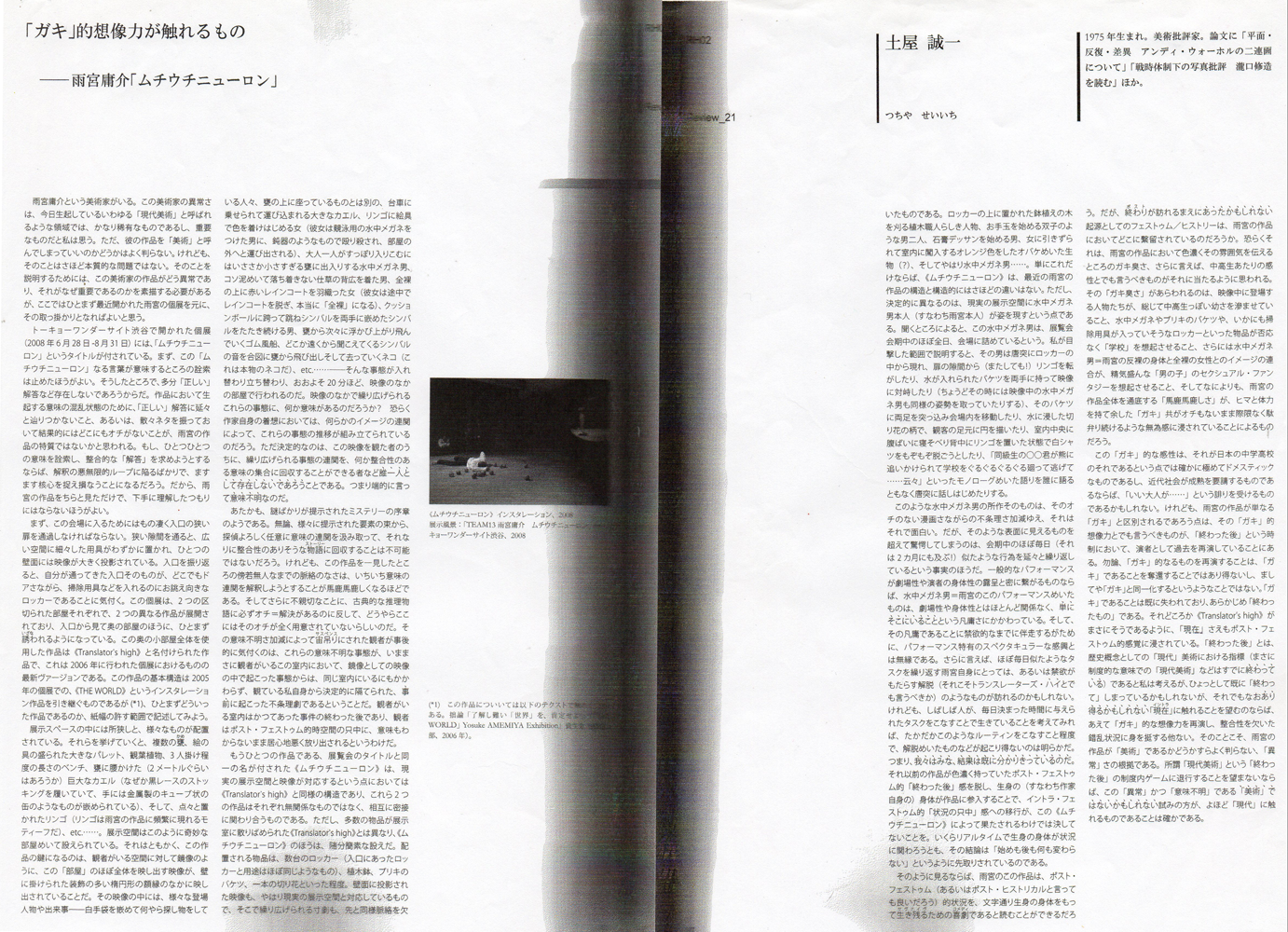
 Oct 2008 Book (JP)
Oct 2008 Book (JP)
Review House 02 「ガキ」的想像力が触れるもの ーー雨宮庸介「ムチウチニューロン」

 Magazine (JP)
Magazine (JP)
AERA 2006 Text: Mari Hashimoto
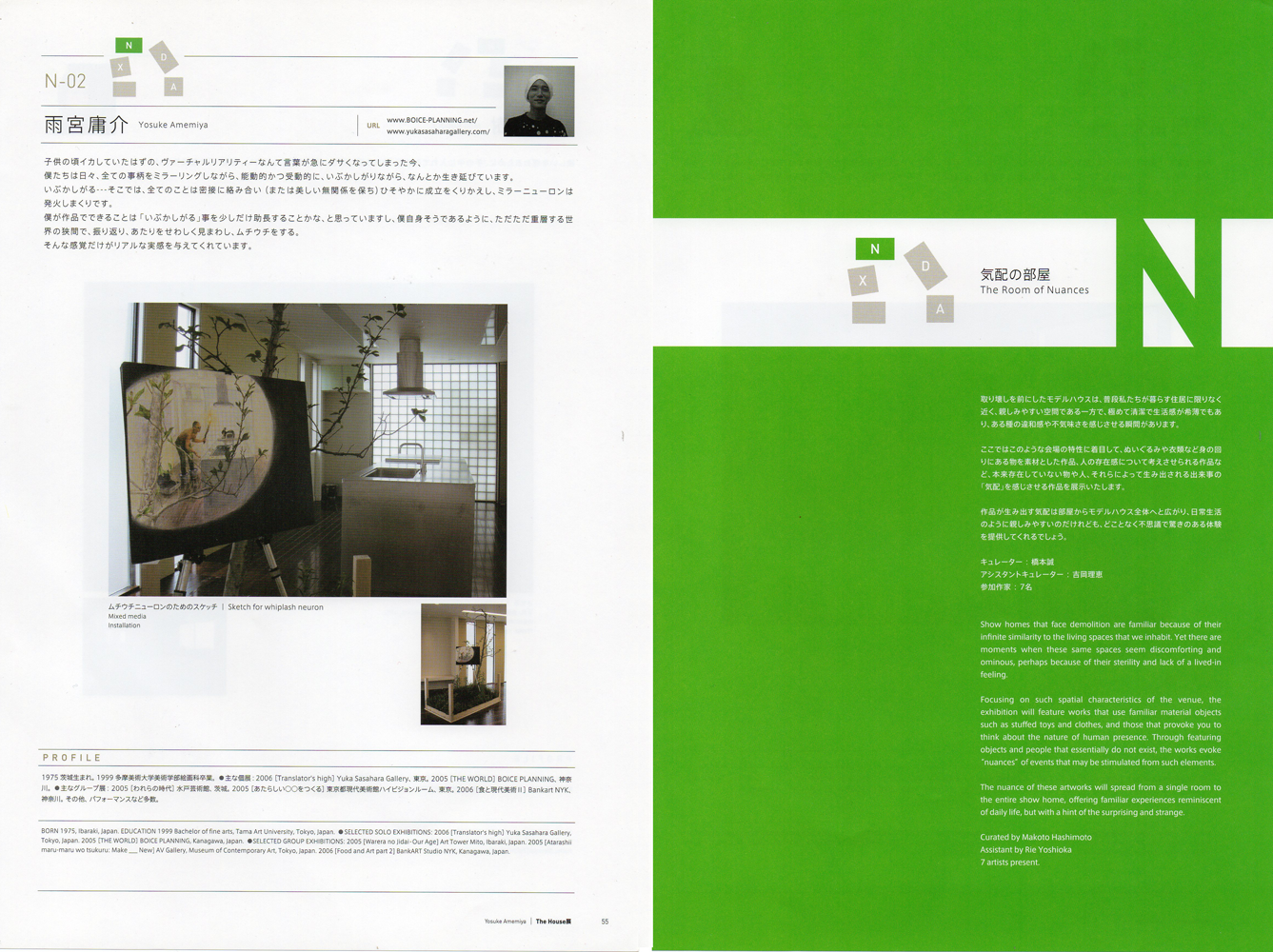
 Aug 2008 Catalogue (JP/EN)
Aug 2008 Catalogue (JP/EN)
The House -The Room of Nuances-
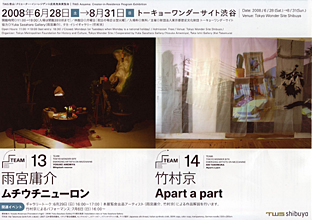
 Aug 2008 Catalogue (JP/EN)
Aug 2008 Catalogue (JP/EN)
Whiplash Neuron, TEAM: Tokyo Wander Site: Emerging Artists on Mezzanine 13, Tokyo
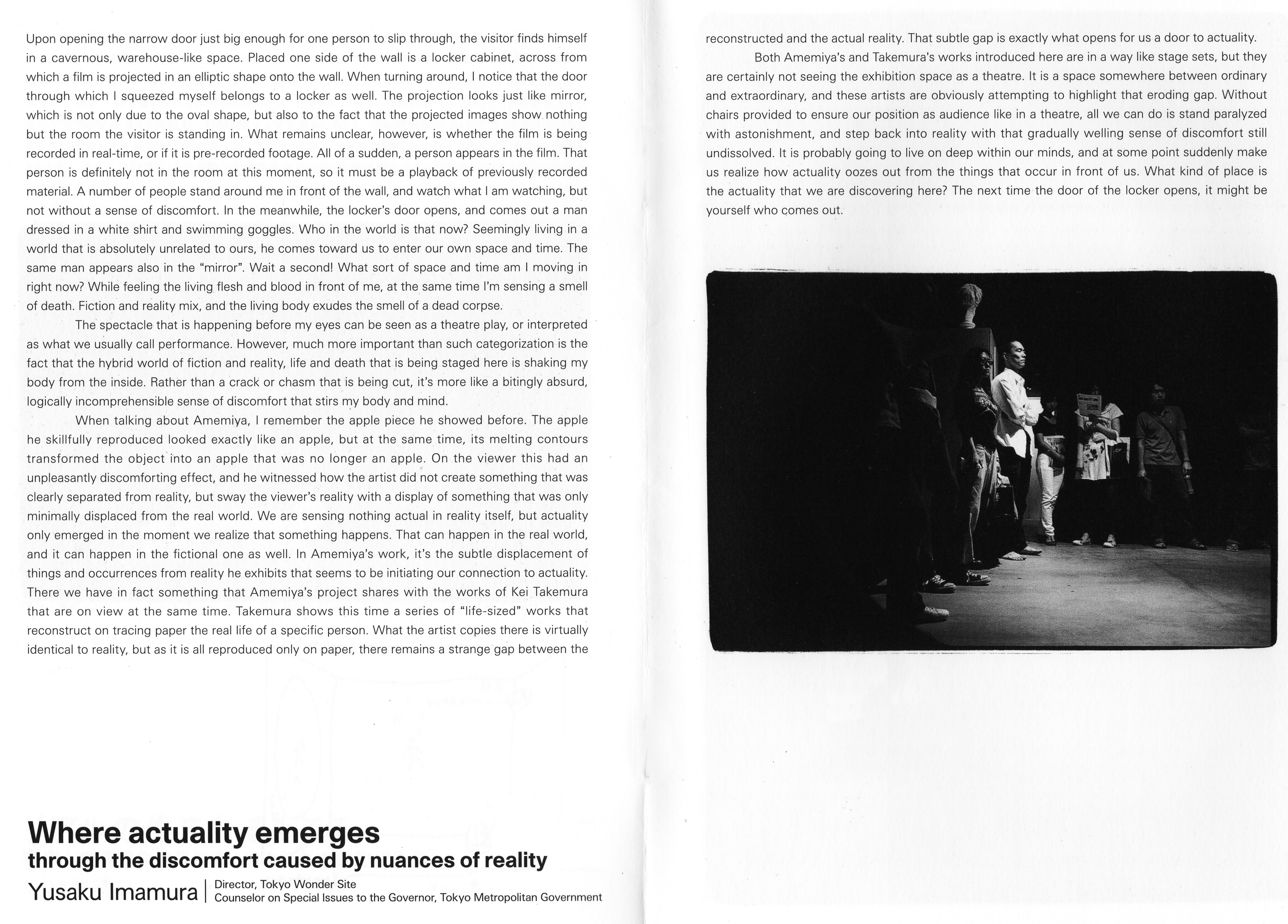
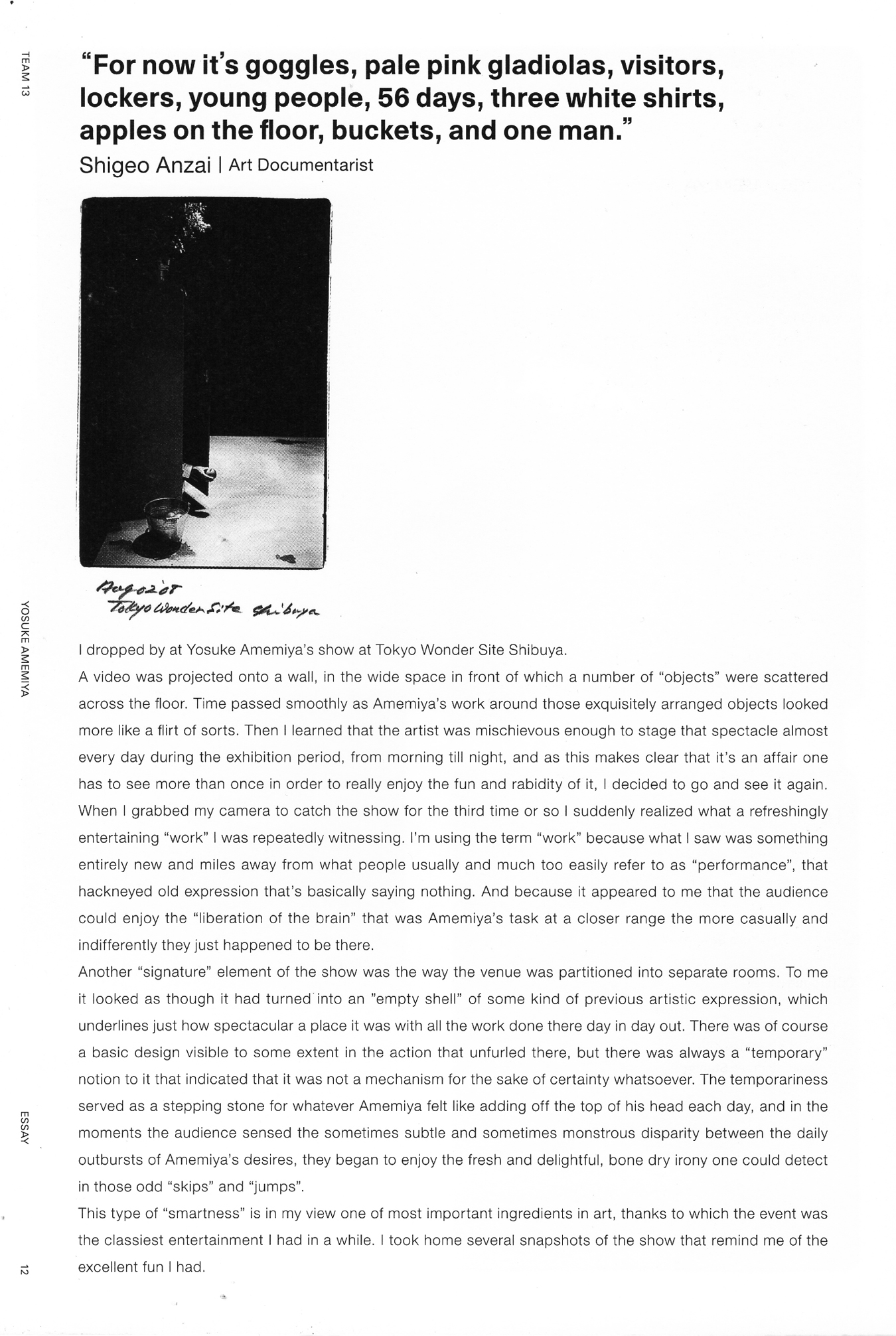
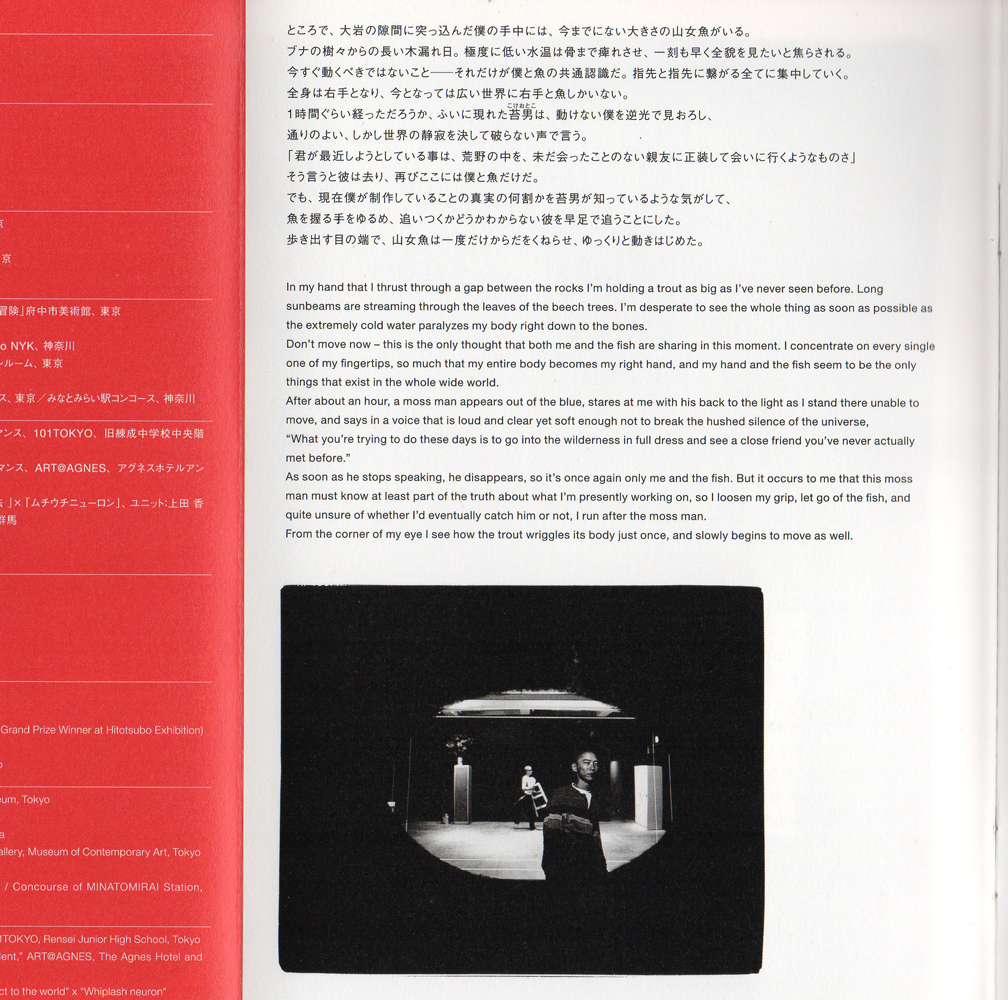

 Jun 2006 Book (JP)
Jun 2006 Book (JP)
BT bijutsu techo ZEROZERO GENERATION NIPPON2
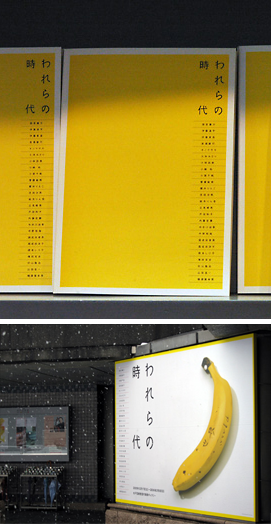
 Aug 2008 Catalogue (JP/EN)
Aug 2008 Catalogue (JP/EN)
Warera no Jidai - Our Age, Art Tower Mito, Ibaraki
Text: Shinya Koizumi
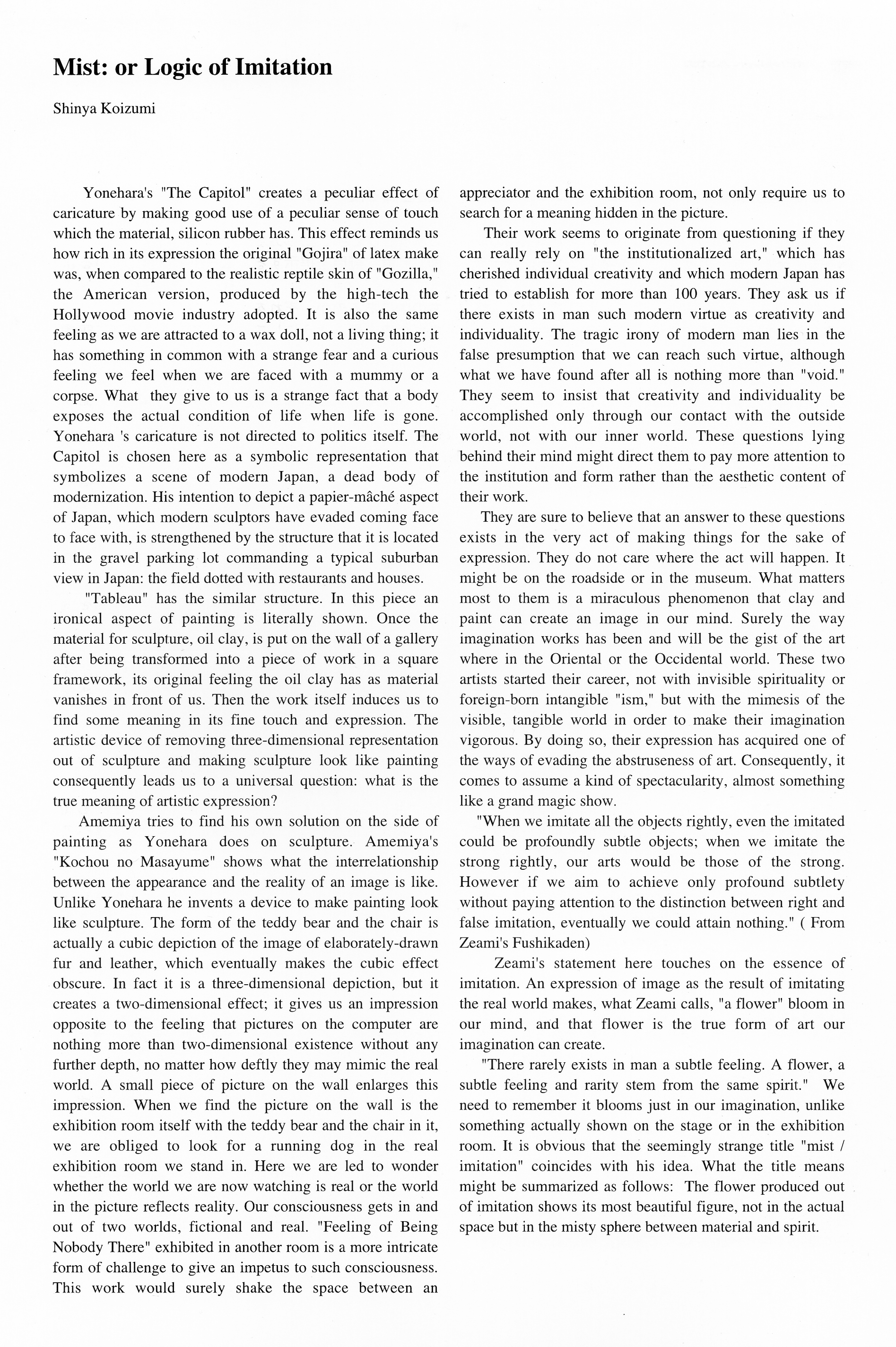
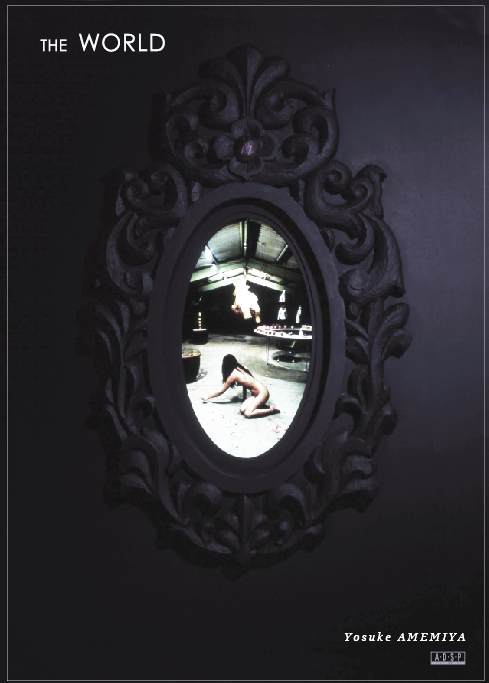
 Oct 2005 Catalogue (JP/EN)
Oct 2005 Catalogue (JP/EN)
The World, BOICE PLANNING, Kanagawa
Shiseido ADSP
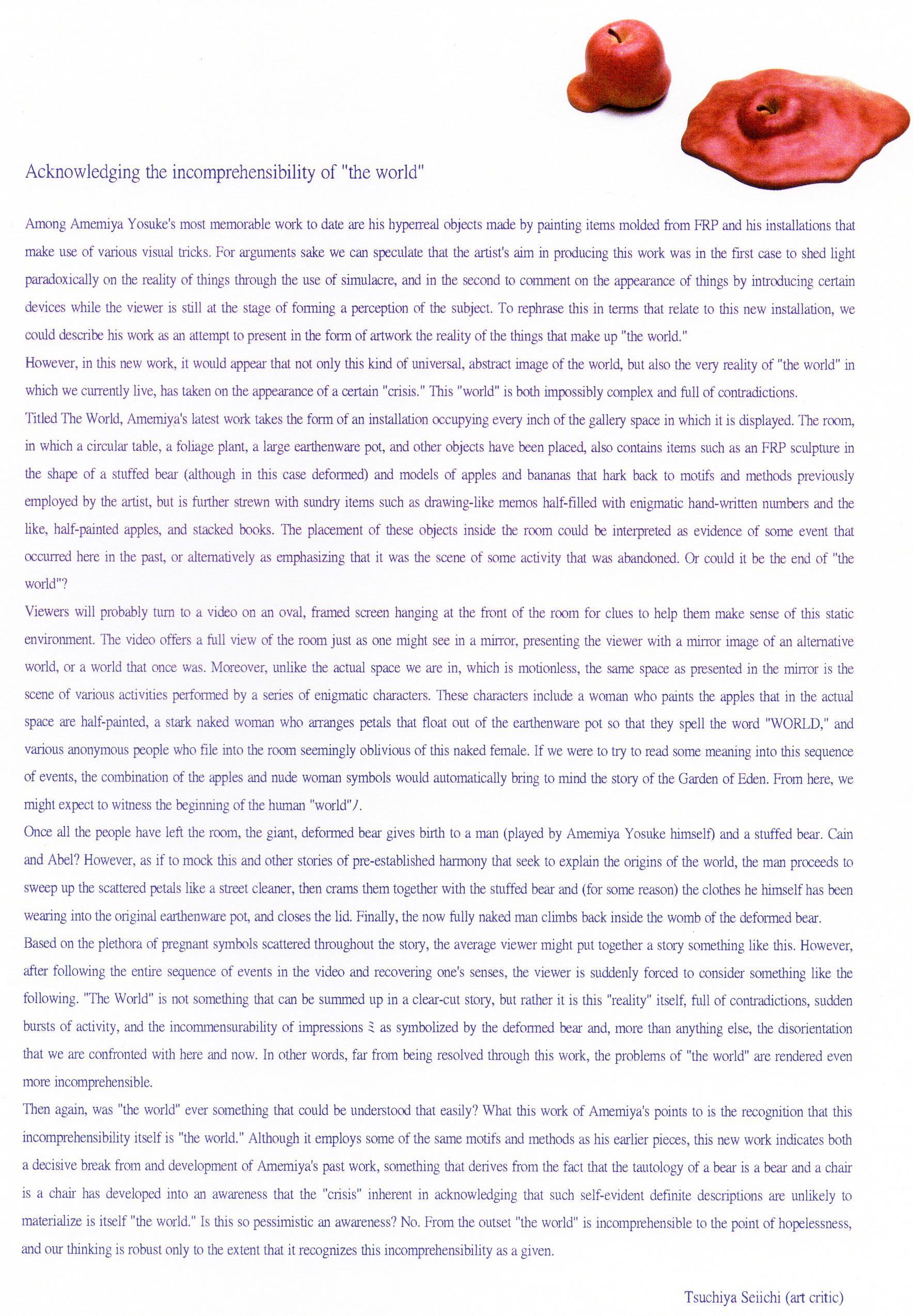
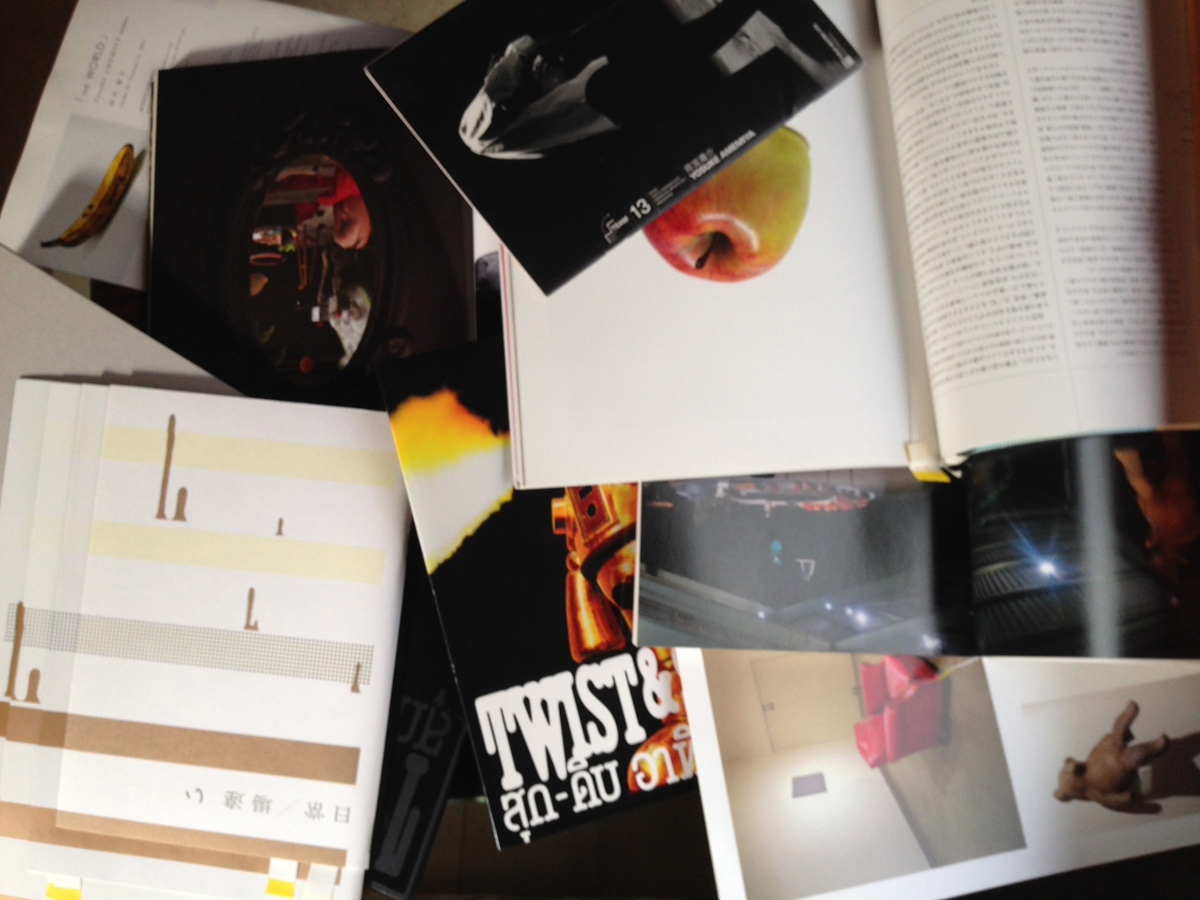
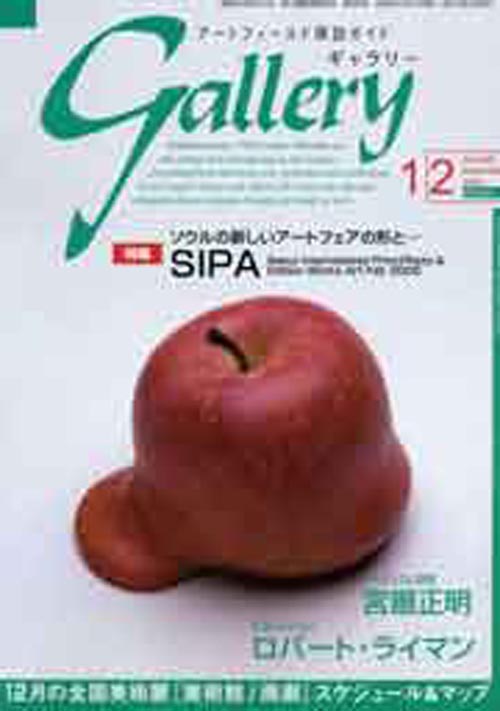
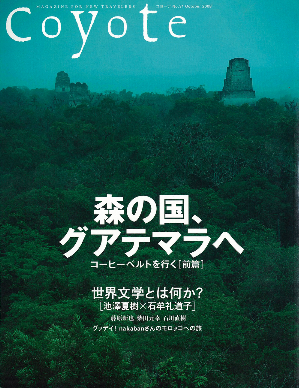
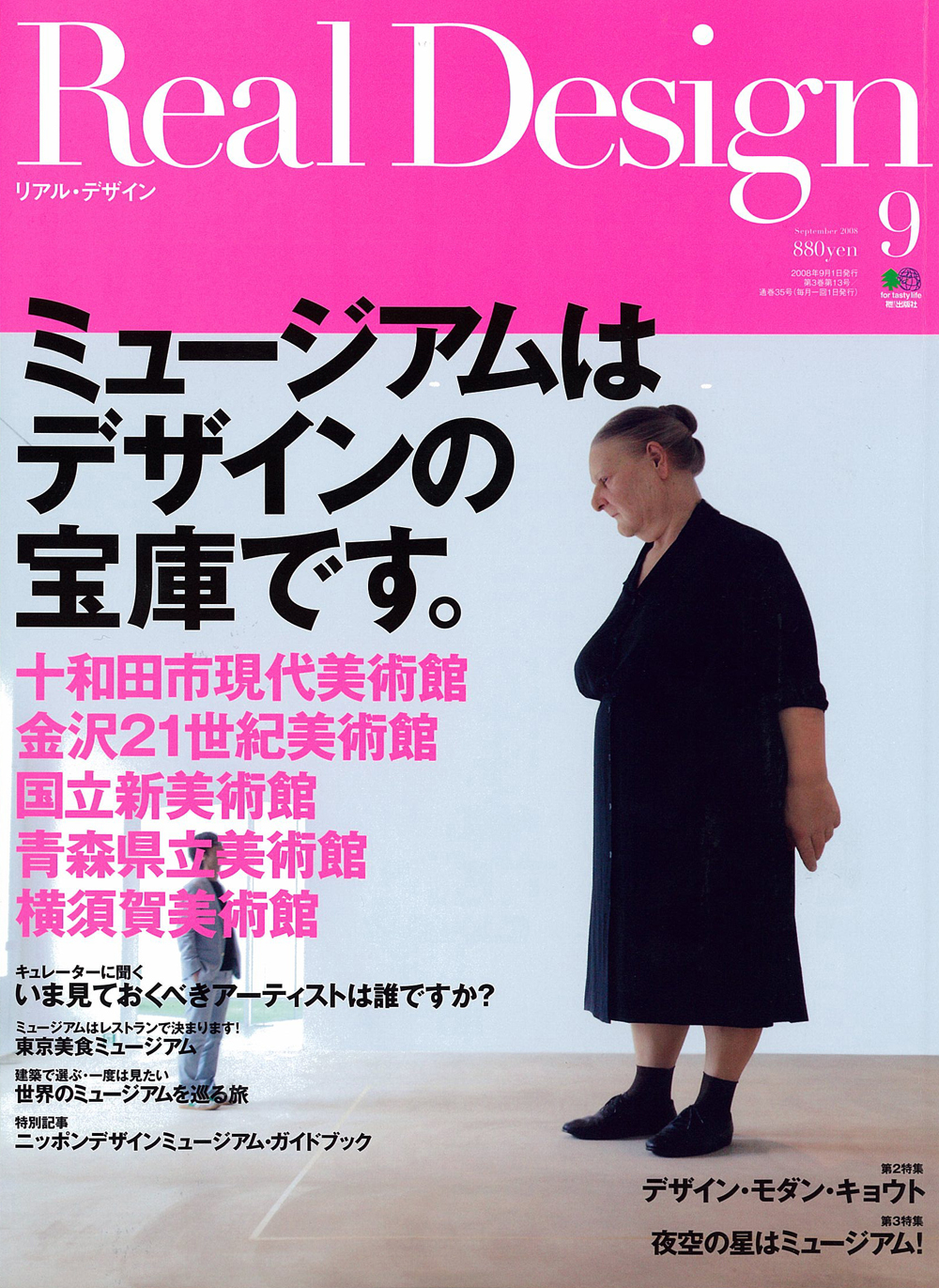
こちら側の部屋でも、あちら側の部屋でも時間は同じように
均一に経過している。両者は同じ時間性の中にある。
村上春樹『アフターダーク』講談社文庫 2006年刊 132頁
「日常/場違い」展。雨宮庸介の展示室。表から見ると周りは、白い壁に囲まれている。壁には唯一、室内への入口として小さな扉がある。扉をそっと開け中に入ってみる。そこは暗い部屋だ。目を凝らしあたりを見る。ロッカーが置いてある。10人くらいの社員がいる小さな会社の引越し。新たな事務所に運ばれるまで、一時的に倉庫に保管されているかのように、これらのロッカーはあちらこちらを向き無造作に置かれている。振り返ってみるとロッカーの扉が1つ開いている。この部屋に入るときに自分が開けた扉だ。部屋の中から見るとそれはロッカーの扉なのだ。つまり自分は、ロッカーの中を通り抜けてこの世界に入り込んだ。部屋の壁の1面にスクリーンがある。スクリーンには、今自分がいる部屋と同じ部屋が対称的に映し出されている。部屋の中のロッカーを数えてみる。11個だ。映像の中にもロッカーが11個。22個のロッカーがこの空間にある。
スクリーンを見ていると、ロッカーの扉を開けて男が現れた。自分が立っている実世界と映像で作られた「向こう側の世界」。この2つの世界が向き合う1つの空間に自分と男、2人がいる。男は水泳で使うゴーグルをつけている。ゆえにこの男の表情は極めて分かりにくい。仮にこの人物を「ゴーグル男」と呼ぼう。上半身裸のゴーグル男は、金物のバケツを持っている。そして、バケツに入った水を別のバケツに移す行為を続ける。突然、画面が変わる。今度は、オレンジ色の大きな袋を頭からすっぽりとかぶり、袋からにょっきりと生えた足しか見ることのできない奇怪な人物がロッカーから現れた。この人物を「袋小僧」と呼ぶことにする。袋小僧は、部屋の中を徘徊し、立ったり座ったり忙しない。またもや、画面は変わり、ゴーグル男のシーンに戻る。スクリーンには、これらのシーンが繰り返される。映像をじっくり見てみる。すると自分は生身の人間であり、ゴーグル男と袋小僧や他の登場人物は映像上の存在であるという境界が次第に薄れていく。ここには、確かに自分と彼ら、「わたしたち」がいる。自分は、ロッカーに囲まれた世界でじっと繰り返される彼らの行為を見続ける。時間の過ぎるのを忘れて。いつまでもずっと。
*
雨宮庸介は、多摩美術大学卒業からこれまでにいたる自らの創作活動で、厳密な区分けはできないが2つの段階があると考える。そして本展の新作《わたしたち》は、新たな創造に展開する3期目の入口である、と雨宮はいう。
これまでの彼の作品を概観してみよう。
第1期は、1999年から2004年までと考えられる。大学の卒業前後から約5年間だ。この時期は、自然や日常に存在する事物や状況を雨宮の視点でスライドさせた作品が特徴である。初期の作品《擬態》(1999年)[fig.*]では、畳の上に背中に畳の地肌が描かれた蛙が這っている。生物が他の無生物に形態を変化させ、外敵から身を守る自然界の身体的知恵「擬態」。雨宮は、和室を使い蛙が畳に身を隠すという状況をつくり出した。そして、われわれが田畑や自然のなかで目にする蛙の姿から畳に同化する物体へと移行させて見せることで、逆説的に身を隠そうとする蛙の本来の姿を際立たせている。
第2期は、2005以降から現在であるといえる。代表作《THE WORLD》(2005 ) [fig.*]では、林檎、熊のぬいぐるみや植物を展示室に置き、鑑賞者への公開前にその空間で雨宮や裸の女性が登場するドラマが撮影される。展示室では、実際にオブジェが置かれた空間で彼らが過ごす時間と、鏡を模った画面に映される事前に撮影されたドラマの時間が同時に進行する。見ている者の時間。映像の中で進む時間。1つの空間で平行に時間が過ぎて行く2つの異なる世界は、彼らに不思議な感覚を与える。そして、彼らの側の世界には、雨宮が極めて巧緻に制作した林檎のオブジェと本物の林檎が混ぜ合わせて展示されている。多くの人々は、本物の林檎か彼が作った林檎のオブジェかということに感心を寄せる。雨宮庸介にとって、林檎が本物か否かは重要なことではない。彼は、単に外観によるものの見え方ではなく、ここにある事物がどのようにわれわれと関わっているかを問うている。実世界と映像世界が空間に共存すること。同じ関係が林檎でいうところの本物とオブジェの関係でも繰り返されていている。雨宮は、彼が作りだした事物を使って真偽の見え方の境界をあいまいにし、あえて不明瞭な状況を作り出す。そして、彼の拵えたこの状況は、世界のありようをわれわれに覚醒させようと迫ってくる。 この雨宮の手法は《ムチウチニューロン》(2008年)[fig.*]でさらに発展する。この作品の展示室は《THE WORLD》と同じような状況が設定されるが、雨宮は、この展示空間に雨宮の身体そのものを存在させた。56日間という会期中彼は、毎日林檎や水の入ったバケツを使ってパフォーマンスを行う。映像に映し出される「向こう側の世界」にいる雨宮庸介と鑑賞者とともに実世界を共有する雨宮庸介。同じ人物、とりわけ作家本人を2重に存在させることにより、彼は、われわれに展示室で目にする物体、状況、さらにわれわれの目の前にいる雨宮自身との関係をより強く求め、「世界」とはいかなるものかの問いを与える。
「『私』がどこで終わり、『私たち』がどこで始まるのか?」雨宮の命題だ。彼は、この命題をわれわれの命題としても投げかけてくる。オブジェ、インスタレーション、映像、彼の身体など様々なアイテムにより構成される雨宮の作品。その作品のなかで、アイテムとわれわれは、映像対実世界のように単一的な関係ではない。雨宮は、それら諸要素が絡み合うその合間には、曖昧な幾つもの位相があることを示し、しかもその位相の場にわれわれ自身も引き込むことで、われわれに世界を共有させようとしているのだ。
今回の新作《わたしたち》。この映像に登場するゴーグル男と袋小僧やその他の登場人物。彼らのシーンが繰り返される映像を展示空間で体感する鑑賞者。雨宮は、「A,B,A,C,A,B」という音楽の形式でいうところのロンド形式のように基本となる主題の間に異なる旋律が挿入されるようにループする映像を用いたこの作品で、鑑賞者のこれまでの視覚的経験と作品を目の前にした体感を繋ぎ合わせる。経験と体感が繋がることで、雨宮庸介が展示室でつくりだした世界を通して、単体としての「私」(鑑賞者)から雨宮とともに「私たち」という複数で成立する世界が始まる。
中野仁詞 (本展キュレーター)







BT exhibition review 『本当の色』はどこからやってくるのか
Text:粟田大輔 Daisuke Awata

The 4th Fuchu Biennial - TRUE COLORS
Fuchu Art Museum, Tokyo
Text:Hajime Nariai
http://www.museum.or.jp/modules/im_event/?controller=event_dtl&input%5Bid%5D=54221
Text:Hajime Nariai
http://www.museum.or.jp/modules/im_event/?controller=event_dtl&input%5Bid%5D=54221
For the exhibition TRUE COLORS
I don't know long I'd been running, but I'm fast, and finally caught up with the Bear, as I knew I would. The Bear was working hard to keep up with those in front, and I was less afraid of his hairy back than what was behind me. I was interested in what was before my eyes and frightened by what was behind them. I was fast, and after a while became irritated at the slowpoke Bear. But I knew this was no footrace, and that I shouldn't pass him.
I don't know long I'd been running, but at some point, the ring of classmates around the school building reversed direction.
I found my friend John and, in the same tone I'd used before, asked him, "What's going on?" The Bear is chasing me," he said, short of breath. Leaving him behind, I caught up with speedy Marcel and ask him, "What's going on? "It was you who took the Bear's honey, wasn't it?" he said.
Now, everybody was chasing me. To tell the truth, I was disgusted when I found that sticky pot in my pocket, but was surprised how easy it was to slip out of the ring, catch my breath, and the throw the pot on the ground. The pot rolled wildly. The swift Bear Marcel glanced at me and then turned in my direction. I casually rejoined the ring, and decided to find my pal John.
I don't know how long I'd been running, and lost count after thirty-one laps.
Then, out of breath, I found myself wondering what he meant when he said, "Even if you don't count the subatomic particles, or decide not to look for the lost dog, you can still see the escort runners. "I call my interpretation of this---and my whispering of it into the ears of you readers---my artwork and may current task.
展覧会によせて 雨宮庸介
どのくらい走っただろうか、僕は脚が速かったので、とうとう追われているはずの「熊」に追いついてしまった。「熊」は前方を追う事に勤しみ、僕は僕で、目の前で動く毛むくじゃらの背中より、自分の背後の方がよっぽど具体的な恐怖だ。興味は眼球の向く方にあり、恐怖は眼球と反対向きにある。暫くすると、僕は脚が速かったので、脚の遅い「熊」に苛立ちをおぼえはじめた。でもこれは徒競走では無いし環状になっているのだから「熊」を追い越すべきではない事はさすがにわかっている。
どれくらい走っただろうか、校舎を中心とした同級生のドーナッツは誰が言い出すでもなく逆回りになった。僕は仲の良かった中嶋君を見つけて「どうしたの?」と、できるだけ前回と同じ調子で尋ねてみた。「熊に追われているんだ」と、さらに息切れする彼を後目に、脚の速かった寺島君に追いついて「どうしたの?」と尋ねると、強い語尾で返してくる。「でもさ、熊の蜂蜜を盗ったのは君だろう?」
そういうわけで、今度は同級生が僕を追う事になった。ポケットにあるベタベタの壷に気付いた時には、正直言ってひいたけど、ドーナッツからそっと抜けるのは思いのほか容易で、ひといきついて僕は壷を地面に転がした。壷は思ったよりも騒がしく転がり、脚の速かった「熊」の寺島君は僕の方を一瞥すると、体をこちらに向けなおした。僕は再びさりげなくドーナッツに戻り、先ずは仲の良かった中嶋君を捜す事にした。どのくらい走っただろうか、そのご31周まで数え、あとは判らなくなってしまった。
そして、息を切らした僕が知りたかったことはこの先のことで、彼が言った「なくなった素粒子を数えなくても、いなくなった犬を探さなくても僕には伴奏者が見えるんだ」それがどんなことなのか僕なりの解釈を、今読んでいるあなたに耳打ちすること、それを作品と呼び、とりあえずの使命としているのです。
I don't know long I'd been running, but I'm fast, and finally caught up with the Bear, as I knew I would. The Bear was working hard to keep up with those in front, and I was less afraid of his hairy back than what was behind me. I was interested in what was before my eyes and frightened by what was behind them. I was fast, and after a while became irritated at the slowpoke Bear. But I knew this was no footrace, and that I shouldn't pass him.
I don't know long I'd been running, but at some point, the ring of classmates around the school building reversed direction.
I found my friend John and, in the same tone I'd used before, asked him, "What's going on?" The Bear is chasing me," he said, short of breath. Leaving him behind, I caught up with speedy Marcel and ask him, "What's going on? "It was you who took the Bear's honey, wasn't it?" he said.
Now, everybody was chasing me. To tell the truth, I was disgusted when I found that sticky pot in my pocket, but was surprised how easy it was to slip out of the ring, catch my breath, and the throw the pot on the ground. The pot rolled wildly. The swift Bear Marcel glanced at me and then turned in my direction. I casually rejoined the ring, and decided to find my pal John.
I don't know how long I'd been running, and lost count after thirty-one laps.
Then, out of breath, I found myself wondering what he meant when he said, "Even if you don't count the subatomic particles, or decide not to look for the lost dog, you can still see the escort runners. "I call my interpretation of this---and my whispering of it into the ears of you readers---my artwork and may current task.
展覧会によせて 雨宮庸介
どのくらい走っただろうか、僕は脚が速かったので、とうとう追われているはずの「熊」に追いついてしまった。「熊」は前方を追う事に勤しみ、僕は僕で、目の前で動く毛むくじゃらの背中より、自分の背後の方がよっぽど具体的な恐怖だ。興味は眼球の向く方にあり、恐怖は眼球と反対向きにある。暫くすると、僕は脚が速かったので、脚の遅い「熊」に苛立ちをおぼえはじめた。でもこれは徒競走では無いし環状になっているのだから「熊」を追い越すべきではない事はさすがにわかっている。
どれくらい走っただろうか、校舎を中心とした同級生のドーナッツは誰が言い出すでもなく逆回りになった。僕は仲の良かった中嶋君を見つけて「どうしたの?」と、できるだけ前回と同じ調子で尋ねてみた。「熊に追われているんだ」と、さらに息切れする彼を後目に、脚の速かった寺島君に追いついて「どうしたの?」と尋ねると、強い語尾で返してくる。「でもさ、熊の蜂蜜を盗ったのは君だろう?」
そういうわけで、今度は同級生が僕を追う事になった。ポケットにあるベタベタの壷に気付いた時には、正直言ってひいたけど、ドーナッツからそっと抜けるのは思いのほか容易で、ひといきついて僕は壷を地面に転がした。壷は思ったよりも騒がしく転がり、脚の速かった「熊」の寺島君は僕の方を一瞥すると、体をこちらに向けなおした。僕は再びさりげなくドーナッツに戻り、先ずは仲の良かった中嶋君を捜す事にした。どのくらい走っただろうか、そのご31周まで数え、あとは判らなくなってしまった。
そして、息を切らした僕が知りたかったことはこの先のことで、彼が言った「なくなった素粒子を数えなくても、いなくなった犬を探さなくても僕には伴奏者が見えるんだ」それがどんなことなのか僕なりの解釈を、今読んでいるあなたに耳打ちすること、それを作品と呼び、とりあえずの使命としているのです。

Review House 02 「ガキ」的想像力が触れるもの ーー雨宮庸介「ムチウチニューロン」

AERA 2006 Text: Mari Hashimoto

The House -The Room of Nuances-
curation: Makoto Hashimoto

Whiplash Neuron, TEAM: Tokyo Wander Site: Emerging Artists on Mezzanine 13, Tokyo
Text: Yusaku Imamura Photo&Text:Shigeo Anzai
http://www.tokyo-ws.org/english/creator/a/yosuke-amemiya.shtml
http://www.tokyo-ws.org/english/creator/a/yosuke-amemiya.shtml




BT bijutsu techo ZEROZERO GENERATION NIPPON2

Warera no Jidai - Our Age, Art Tower Mito, Ibaraki
Text: Shinya Koizumi


The World, BOICE PLANNING, Kanagawa
Shiseido ADSP






